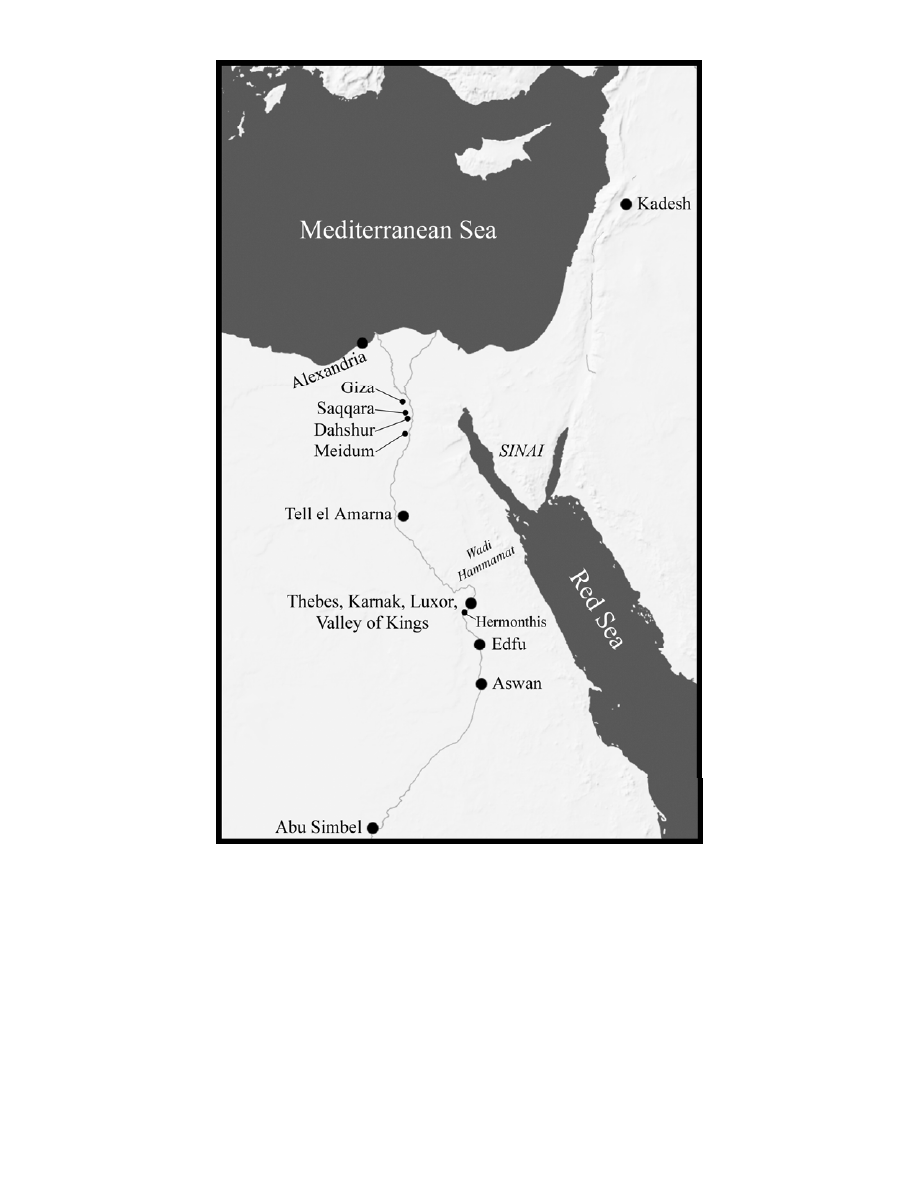
Great Pharaohs
of Ancient Egypt
Professor Bob Brier
T
HE
T
EACHING
C
OMPANY
®


©2004 The Teaching Company Limited Partnership
i
Bob Brier, Ph.D.
Professor of Egyptology, Long Island University
Bob Brier was born in the Bronx, where he still lives. He received his bachelor’s
degree from Hunter College and his Ph.D. in philosophy from the University of
North Carolina at Chapel Hill in 1970. From 1981–1996, he was Chairman of
the Philosophy Department at the C.W. Post campus of Long Island University.
He now focuses primarily on research and teaching Egyptology courses. He was
director of the National Endowment for the Humanities’ Egyptology Today
program and has twice been selected as a Fulbright Scholar. He is also the
recipient of the David Newton Award for Teaching Excellence.
In 1994, Dr. Brier became the first person in 2,000 years to mummify a human
cadaver in the ancient Egyptian style. This research was the subject of a
National Geographic television special, Mr. Mummy. Dr. Brier was also the host
of The Learning Channel’s series: The Great Egyptians, Unwrapped: The
Mysterious World of Mummies, and Mummy Detectives.
Professor Brier is the author of Ancient Egyptian Magic (Morrow, 1980),
Egyptian Mummies (Facts on File, 1994), Encyclopedia of Mummies (Facts on
File, 1998), The Murder of Tutankhamen (Putnam’s, 1998), Daily Life in
Ancient Egypt (Greenwood, 1999), and numerous scholarly articles.

©2004 The Teaching Company Limited Partnership
ii
Table of Contents
Great Pharaohs of Ancient Egypt
Professor Biography ........................................................................................... i
Course Scope ...................................................................................................... 1
Lecture One
King Narmer—The Unification of Egypt ................. 3
Lecture Two
Sneferu—The Pyramid Builder ................................ 6
Lecture Three
Hatshepsut—Female
Pharaoh ................................. 10
Lecture Four
Akhenaten—Heretic
Pharaoh ................................. 14
Lecture Five
Tutankhamen—The Lost Pharaoh .......................... 18
Lecture Six
Tutankhamen—A Murder Theory .......................... 22
Lecture Seven
Ramses the Great—The Early Years ...................... 25
Lecture Eight
Ramses the Great—The Twilight Years ................. 29
Lecture Nine
The Great Nubians—Egypt Restored ..................... 33
Lecture Ten
Alexander the Great—Anatomy of a Legend ......... 36
Lecture Eleven
The First Ptolemies—Greek Greatness................... 40
Lecture Twelve
Cleopatra—The Last Pharaoh................................. 44
Map .................................................................................................................. 49
Timeline ............................................................................................................ 50
Glossary ............................................................................................................ 51
Bibliography..................................................................................................... 52

©2004 The Teaching Company Limited Partnership
1
Great Pharaohs of Ancient Egypt
Scope:
This is an introductory course for anyone interested in ancient Egyptian
civilization. By presenting this history in terms of the lives of its rulers, it should
be easy to assimilate and difficult to forget. We will not worry much about
dates—everyone forgets them anyway. Rather, we will trace the rise of Egypt
from a scattering of villages along the Nile to the greatest power the world had
ever seen, through the lives of the pharaohs.
Egypt ruled the Near East because of its great kings and queens. As the world’s
first nation, Egypt’s power was concentrated in the hands of a single person, the
pharaoh. If the pharaoh decided a pyramid should be built, it was built. Because
of this political structure, the nation could do great things—if it had the right
ruler.
All nations have icons—the American bald eagle, the cedars of Lebanon, the
Eiffel Tower, Big Ben—but in Egypt, this icon was the king. For 3,000 years,
the pharaoh smiting his enemy was the national symbol. Even the Egyptian
calendar was reckoned in terms of the pharaoh’s reign; thus, it is appropriate
that its history be told in terms of its rulers.
This course will be a kind of People magazine set in ancient Egypt. By
recounting the lives and accomplishments of the great leaders of Egypt, we will
present a history of the country spreading over 30 centuries, covering all aspects
of ancient Egyptian life. We will begin with Narmer, the first king of unified
Egypt, and through his reign, we will show how the seeds of Egypt’s greatness
were sown around 3200
B.C
. We will see how the government influenced food
production and how the people of Egypt benefited for the next 30 centuries.
As we continue through the centuries, we will meet the pharaoh Sneferu, who
perfected the art of building pyramids, and see how his belief in life after death
was intertwined with his building projects. Building was the signature of
Sneferu’s reign, but other pharaohs had other interests. When we discuss Queen
Hatshepsut’s reign, we will see that women had such incredible power in
ancient Egypt that Hatshepsut could declare herself “king” and rule as pharaoh.
The pharaoh Akhenaten will be our window into ancient Egyptian religion. The
first person recorded in history to say that there was but one god, Akhenaten’s
attempt to force the people of Egypt to give up their many gods almost
destroyed the country. The life of Ramses the Great will show us what life in the
Egyptian army was like, and we will even discuss the theory that Ramses was
the pharaoh of the Exodus.
Each pharaoh discussed in our 12 lectures has his or her own fascinating story,
and each will lead us to different aspects of Egyptian civilization. We will
discuss magic and mummification, hieroglyphs and art, farming and astronomy.
Often, the fun of history is in the details. Knowing what kind of wine

©2004 The Teaching Company Limited Partnership
2
Tutankhamen preferred makes him come alive. Understanding that Ramses the
Great was crippled by arthritis for the last decade of his long life makes us more
sympathetic to the monarch who boasted that he fathered 100 children. As we
wind our way through the biographies of the kings and queens of Egypt, we will
pause to look at the details that make up the big picture. By the time we come to
the last ruler of Egypt, Cleopatra, we will have peered into almost every aspect
of ancient Egyptian life, seen what made Egypt great, and learned what finally
brought about its downfall. We will not discuss every king and queen, every
battle or tomb, but my hope is that by the end of the course, you will have a
sense that you personally know the men and women who made Egypt the
greatest nation of the ancient world.

©2004 The Teaching Company Limited Partnership
3
Lecture One
King Narmer—The Unification of Egypt
Scope: We begin by meeting the pharaohs we will discuss in this course and
defending our approach to studying Egyptian history, that is, to look at
history through the lives of great individuals, rather than to analyze
events and circumstances. We then discuss what Egypt was like before
kingship, and we see Egypt become the first nation in history. We also
consider the first historical document in the world—the Narmer Palette.
From the time of the unification of Upper and Lower Egypt by King
Narmer, it would take only a few hundred years to build a power that
would dominate the Near East for thousands of years. We show how
the political structure of ancient Egypt made this possible and how the
Narmer Palette tells the story.
Outline
I. This course presents the history of Egypt through the memorable
personalities of the great pharaohs.
A. We begin with Narmer, the first king of Egypt, then move on to
Sneferu, the builder of pyramids, and Hatshepsut, a woman who ruled
Egypt as king. After Hatshepsut, we turn to Akhenaten, who
introduced monotheism and almost destroyed Egypt, then look at
Akhenaten’s son, Tutankhamen, followed by Ramses the Great, who
ruled for 67 years.
B. After Ramses, we discuss the Late Period and the Nubian kings of the
south before moving on to the very end of Egyptian history, when the
Greeks ruled. We close with a look at Alexander the Great, the
Ptolemies, and the last of the Ptolemies, Cleopatra.
C. Our approach in this course—examining the lives of great
individuals—bucks 2,500 years of tradition.
1. The Greek historian Herodotus noted, around 450
B.C
., “Egypt is
the gift of the Nile.” Because the Nile overflowed its banks every
year, Egypt received an annual deposit of rich topsoil. This
renewal enabled Egypt, throughout its history, to grow more food
than it needed and, in turn, to support a standing army. For
Herodotus, then, the Nile is what made Egypt great.
2. In contrast, my thesis is that Egypt’s greatness stems from its
leaders.
D. One point to remember before we begin is a bit of geography: The Nile
flows from south to north. The terms Upper and Lower Egypt refer to
the direction of the Nile. Upper Egypt, then, is in the south, and Lower
Egypt is in the north.

©2004 The Teaching Company Limited Partnership
4
II. Our best guess for the period of the life of Narmer, first king of Egypt, is
around 3200
B.C
.
A. Just before Narmer’s time, Egypt was divided into two kingdoms,
Upper and Lower Egypt.
1. The kings of these regions were symbolized by their crowns. The
king in the south wore a tall, white crown, conical in shape. The
pharaoh in the north wore a shorter, red crown.
2. Interestingly, no crown has ever been found. The crown may have
been considered magical, lending power to its wearer. For this
reason, the crown was passed down from king to king; it could not
be taken to the next world by the departing pharaoh.
B. Sometime around 3150
B.C
., Narmer, a king of the south, conquered
the north, and Egypt became one nation. In doing so, Narmer
established the political schema that would make Egypt great for 3,000
years.
III. The Narmer Palette (3150
B.C
.), the world’s first historical document, tells
the story of the unification of Egypt.
A. The Narmer Palette is a piece of slate about 22 inches long and 24
inches wide. It was probably a ceremonial palette used to grind
cosmetics that anointed statues of the gods.
B. The Narmer Palette is carved on both sides with the story of Narmer’s
conquest.
1. On one side of the palette is a king wearing the tall, white crown
of the south and holding a mace. He is poised to smite an enemy
whom he is holding by the hair.
2. How do we know this king is Narmer? At the top of the palette is a
small rectangle representing a palace façade. Inside the rectangle
are two small objects, a fish and a chisel. The pronunciations of
these two words combine to form the name Narmer.
3. The Narmer Palette contains the first hieroglyphic inscriptions,
which were not just phonetic or pictographic. Hieroglyphs are a
mixture of these two systems of writing.
4. On the same side of the palette is a falcon depicted holding a
captive, who has a ring through his nose. The falcon is the god
Horus, who is traditionally associated with the pharaoh.
5. On the other side of the palette, Narmer is shown in a procession
wearing the red crown. His size, twice as large as anyone else on
the palette, is another indication of his importance. This is the first
example we have of a figure depicted in hierarchical proportion.
6. In front of Narmer in the procession is his vizier, a small, hunched
figure wearing a leopard skin. The procession is marching toward
a group of enemies who have been beheaded.
7. Maybe the most important feature of the Narmer Palette is the
depiction of two mythological beasts with long necks that are

©2004 The Teaching Company Limited Partnership
5
intertwined, forming a circle. The intertwined necks are symbols
of the unification of Egypt.
8. Finally, beneath these two beasts is a bull that has broken down
the wall of a city and is trampling someone within. The bull is
another symbol of the pharaoh in ancient Egypt.
C. The Narmer Palette was probably carved by two different people. The
hieroglyphs show clearly different styles. There may have been some
time separating the carving of the first side and the second side.
IV. Narmer’s achievement—unifying Egypt—had important benefits.
A. Keep in mind that Egypt’s king was a god. Throughout history, from
Plato in The Republic to Thomas Hobbes in Leviathan, thinkers have
recognized that an all-powerful ruler can accomplish great things.
B. Narmer took advantage of the Nile’s yearly overflow to grow an even
greater surplus of food. He directed the digging of irrigation canals,
marshalling the “gift of the Nile” for the general good.
C. As mentioned earlier, the food surplus supported a professional
standing army for Egypt, increasing its power in the Near East.
D. Narmer established the tradition of a strong central government that
would enable Egypt to rule the Near East for the next 3,000 years.
Essential Reading:
Michael Rice, Egypt’s Making, chapter 3.
Supplementary Reading:
Peter Clayton, Chronicle of the Pharaohs, pp. 14–19.
Questions to Consider:
1. What is the story told by the Narmer Palette?
2. What are the advantages of nationhood?

©2004 The Teaching Company Limited Partnership
6
Lecture Two
Sneferu—The Pyramid Builder
Scope: This lecture presents the founder of the “Fabulous 4
th
” Dynasty,
Sneferu. Before we meet him, however, we look at the history of
burials and pyramid building in Egypt. We then turn to Sneferu’s reign,
which saw three major innovations: (1) By trial and error, true pyramid
construction began; (2) Egypt became an international power through
trade with Lebanon and armed expeditions sent to the turquoise mines
in the Sinai; and (3) artistic standards were established that would last
for thousands of years. We close by noting that Sneferu is the first
individual in history about whom we have some personal information:
Legend reveals that he was an approachable, sympathetic king.
Outline
I. In this lecture, we jump forward a few centuries to Sneferu (r. 2613–2589
B.C
.). Under this pharaoh, Egypt would become an international power;
artistic conventions would be established that would last for the next 2,500
years; and the Egyptians would begin to build pyramids. Before we look at
Sneferu, a little background is necessary.
A. Before Narmer’s time, the dead were buried in the desert in sand pits.
The hot, dry climate of the Egyptian desert offers perfect conditions for
natural mummification. Eventually, however, the sand might blow
away, exposing the body to animals.
B. For this reason, Egyptians began to erect a small stone bench
(mastaba) over the burial pit. This practice ultimately became more
elaborate. Egyptians began to dig down into the sand to bedrock,
excavate a chamber for the dead in the bedrock, cover the excavation,
and cap the pit with a mastaba on top.
C. From these more elaborate burial pits, it was only a short step to
pyramid building, which was introduced by another pharaoh, Zoser.
1. The pyramid shape had no special meaning for the Egyptians; it
was simply an architectural development.
2. During the reign of Zoser, his architect enlarged the mastaba
structure by placing progressively smaller benches one on top of
the other. The result was a six-tiered step pyramid, built in
Saqqara, a burial place of the Old Kingdom.
3. This pyramid was the first such structure in the history of the
world and was probably 20 times taller than any other building on
Earth. The Egyptians used stone in construction, because it was the
only material available to them.

©2004 The Teaching Company Limited Partnership
7
4. Zoser’s ability to marshal his people to build pyramids is a legacy
of Narmer, the first powerful central leader of a unified Egypt,
who began, with irrigation channels, the tradition of public works
projects.
II. Sneferu built several pyramids, including the first true pyramid without
stepped sides.
A. Meidum is Sneferu’s first attempt to build a true pyramid. The structure
began as a stepped pyramid, the steps later to be filled in with
limestone.
B. Today, the Meidum pyramid resembles a collapsed tower with a pile of
rubble at its base. One theory holds that the pyramid collapsed while it
was under construction.
1. Next to the pyramid is a small temple where priests could make
offerings for the soul of Sneferu throughout the centuries. On top
of this temple are two stelae (sing., stela; a round-topped stone
carved with an inscription), but they were never inscribed. For this
reason, some scholars believe that the pyramid collapsed before it
could be finished.
2. The burial chamber at Meidum is within the pyramid, not beneath
it. This innovation presents an engineering problem: Literally tons
of rock are bearing down on the ceiling of the burial chamber. A
corbelled ceiling was used to redistribute the weight of the rock
and prevent collapse. Again, the burial chamber was never used.
3. Structural problems may have led to the pyramid’s abandonment,
but later excavations show that it did not collapse during
construction. The limestone casing stones used to fill in the steps
of the pyramid were unstable.
C. Given that the pyramid at Meidum is uninscribed, how do we know
that it was Sneferu’s? Graffiti from the 18
th
Dynasty, 1,000 years after
Sneferu’s reign, tells us that the temple was his.
III. After the abandonment of the pyramid at Meidum, Sneferu’s second
pyramid was begun at Dahshur, a site about 15 miles away from Meidum.
A. This second attempt to build a true pyramid resulted in what is now
called the Bent Pyramid. About halfway up the structure, the angle of
the sides changes, causing a bend in the pyramid.
B. For stability, pyramids cannot be built on sand. The sand must be
cleared away to the bedrock, and the bedrock must be leveled; then, the
blocks can be laid for the foundation. The pyramids at both Saqqara
and Meidum are constructed in this way.
C. Two of the corners of the pyramid at Dahshur are not resting on solid
bedrock. As levels of stone were added to the pyramid, the base began
to shift, causing cracks in the walls of the interior burial chamber,
which had already been constructed.

©2004 The Teaching Company Limited Partnership
8
D. To keep the pyramid from collapsing, Sneferu had thick cedar beams
installed in the burial chamber to brace the walls. He finished the
construction quickly and inexpensively by allowing the bend in the
pyramid, which would require less stone and take some of the pressure
off the interior walls of the burial chamber.
E. Although this pyramid, too, was never used, it was finished to serve as
one of two burial places for Sneferu. Since Narmer’s time, the pharaoh
had two tombs to symbolize his leadership of both Upper and Lower
Egypt.
F. Less than a mile away from Dahshur, Sneferu built a third pyramid, the
Red Pyramid. This structure, built at a more gradual angle than the two
earlier constructions, is the first true pyramid and is the burial place of
Sneferu.
IV. Sneferu’s international policies took him beyond the borders of Egypt.
A. He sent a trading expedition to Lebanon to acquire the cedars used to
brace the walls in the Bent Pyramid.
1. Egyptians were not good ocean sailors; they had been spoiled by
their experience on the Nile, which required them only to follow
the prevailing winds when sailing upriver or the current when
sailing downriver.
2. They called the Mediterranean “The Great Green” and avoided
venturing into its waters.
3. Expeditions to Lebanon, then, were great adventures, but the
Egyptians needed cedar to build ships and massive temple doors.
B. Sneferu also sent armed expeditions to the turquoise mines in the Sinai.
Inscriptions there call Sneferu the “smiter of barbarians in the foreign
territory.” His wife, Hetepheres, had beautiful inlaid turquoise jewelry.
V. Sneferu established artistic traditions that would last for the next 2,500
years. The first life-size statues were sculpted of Sneferu’s family members
during his reign.
VI. Finally, Sneferu is the first individual in history about whom we have
anecdotes; that is, we know a little about him as a person.
A. The Papyrus Westcar, in Berlin, tells us that Sneferu was rowed in a
boat by young ladies wearing exotic fishnet clothing.
B. One of the girls rowing the boat lost her turquoise amulet over the side.
Sneferu calls a magician who parts the waters—centuries before
Moses—and the amulet is retrieved.
C. The story is obviously fictional, but it indicates that Sneferu was an
approachable, sympathetic pharaoh.
Essential Reading:

©2004 The Teaching Company Limited Partnership
9
I. E. S. Edwards, The Pyramids of Egypt, chapters 2 and 3.
Questions to Consider:
1. What were the stages in the development of the true pyramid?
2. Other than pyramids, what was Sneferu’s legacy?

©2004 The Teaching Company Limited Partnership
10
Lecture Three
Hatshepsut—Female Pharaoh
Scope: One of the greatest individuals in Egyptian history, Hatshepsut appears
in no official record. We trace her biography from her marriage at the
age of 12 to her half-brother, Tuthmosis II, to her death as “King of
Upper and Lower Egypt.” We see how a woman handled the three
ways in which a king was supposed to distinguish himself: building,
waging war, and undertaking trading expeditions. After examining her
three major achievements—her temple at Deir el Bahri, the trading
expedition to Punt, and the erection of two great obelisks—we discuss
why her name was systematically erased from Egyptian records. We
also examine her relationship with Senenmut, the commoner who may
have been her lover.
Outline
I. In this lecture, we jump another 1,000 years, to Queen Hatshepsut, but
before we do so, we, again, discuss a bit of background information to
cover the transition.
A. Sneferu left an incredible legacy, a part of which was his son, the
pharaoh Khufu (Cheops), who built the Great Pyramid of Giza.
B. The period of Sneferu, during which all the pyramid building took
place, is called the Old Kingdom. Egyptian civilization collapsed at the
end of the Old Kingdom for unknown reasons.
1. One theory explaining this collapse is that it was brought on by the
cost of pyramid building itself.
2. Another theory puts forth the reverse as an explanation: The loss
of jobs caused by the cessation of pyramid building resulted in the
civilization’s collapse. Remember that the pyramids were built by
free labor, mostly farmers who were unable to work their crops
during inundation.
C. During the dark period between the Old and Middle Kingdoms, petty
princes were probably vying for power. Eventually, Egypt was
reunified under Montuhotep. His descendents ruled during the Middle
Kingdom, and Egyptians experienced a few centuries of prosperity.
D. The Middle Kingdom collapsed when Egypt was invaded by the
Hyksos (“foreign rulers”), who had the advantage of chariots and
horses. The Hyksos dominated Egypt for a century, but with their
expulsion, the New Kingdom emerged.
E. Hatshepsut (r. 1498–1483
B.C
.) was a female pharaoh of the New
Kingdom. All pharaohs were expected to distinguish themselves in

©2004 The Teaching Company Limited Partnership
11
three ways: by waging war, building, and undertaking trading
expeditions. How would a female ruler meet these expectations?
II. Hatshepsut’s father, Tuthmosis I (r. 1518–1504
B.C
.), was a great king.
A. Tuthmosis I knew that, with the collapse of central government at the
end of the Old and Middle Kingdoms, the treasures of the pyramids
had been stolen. For this reason, he decided that he would be buried
secretly in an area that could be guarded. He was the first pharaoh to be
buried in the Valley of the Kings.
B. The tomb of Ineni, the architect of Tuthmosis’s tomb, has been found,
and its walls are inscribed with Ineni’s autobiography. His proudest
achievement was that he built the pharaoh’s tomb in a secret place
“with no one seeing and no one knowing.”
1. For most of its history, Egypt had two capitals: the religious
center, Thebes, in the south and the administrative center,
Memphis, in the north.
2. For 3,000 years, Egyptians lived on the east bank of the Nile but
were buried on the west bank. The west was associated with the
dead because the sun sets in the west and is reborn in the east. Not
surprisingly, the Valley of the Kings is on the west bank of the
Nile, opposite Thebes.
3. The Valley of the Kings is absolutely desolate. The location was
chosen for the tomb of Tuthmosis, because no one could live there.
Further, the valley could be easily guarded, because it has only one
entrance. Tuthmosis’s tomb is carved into the mountainside.
III. When Tuthmosis I died, he left a son, Tuthmosis II, who had a half-sister,
Hatshepsut. Who would rule Egypt?
A. The line of succession in Egypt was matrilineal. A man became king by
marrying a woman who had pure royal blood.
B. A woman could have three relationships with the pharaoh.
1. First, she could be the Great Wife. All the children of the Great
Wife and the pharaoh were royals.
2. The second relationship a woman could have with the pharaoh was
to be a wife. This status offered certain legal rights, but it was not
equal to the Great Wife.
3. The third possibility was to be a concubine.
4. To become pharaoh, a man had to marry the daughter of the Great
Wife.
C. The mother of Tuthmosis II was not the Great Wife, but Hatshepsut’s
mother was. Tuthmosis II married Hatshepsut when he was in his 20s
and she was only 12; through this marriage, Tuthmosis II became
pharaoh.

©2004 The Teaching Company Limited Partnership
12
D. The couple had a daughter, and the marriage lasted for 20 uneventful
years. When Tuthmosis II died, the question of succession arose again.
E. Tuthmosis II had a son, Tuthmosis III, with another wife, but he was
only a child when his father died. The widowed queen Hatshepsut
decided that she would rule as regent until Tuthmosis III came of age.
F. As a woman, Hatshepsut was unable to lead men in battle, but she did
build a beautiful temple, Deir el Bahri (“the place of the northern
monastery”). The walls of the temple tell her story.
1. The inscriptions first relate the circumstances of Hatshepsut’s
birth: The god Amun, disguised as Tuthmosis I, seduced
Hatshepsut’s mother, Ahmose. Thus, Hatshepsut, like other
pharaohs, is divine.
2. Other inscriptions in the temple puzzled early Egyptologists. In
1829, Champollion, who had recently deciphered hieroglyphs,
visited the temple and saw a confusing scene: Tuthmosis III and an
unknown “king” named Hatshepsut.
3. Scholars eventually determined that, after a few years of ruling as
queen, Hatshepsut declared herself king. She began to wear the
trappings of kingship and ruled as pharaoh.
IV. What kind of king was Hatshepsut? The answer, derived from the walls of
Deir el Bahri, is: a great one.
A. One of Hatshepsut’s accomplishments was a trading expedition to
Punt, perhaps in the area of modern Eritrea (near Ethiopia) or Somalia.
1. To make this trek, boats had to be carried to the Red Sea, where
they were launched on a journey southward for 15 days, or about
600 miles.
2. The walls of Deir el Bahri show the land of Punt; these carvings
constitute the first accurate depiction of sub-Saharan Africa in
history. The carvings show thatched houses on stilts and the queen
of Punt and her daughter greeting the expedition.
3. The expedition returned with ivory, incense, and other trade goods.
B. Another achievement of Hatshepsut shown on the walls of the temple
is the erection of obelisks at Karnak temple.
1. Hatshepsut is shown sending the ships off to the quarries at Aswan
to acquire pink granite for the structures.
2. The temple walls also show the obelisks returning to Thebes. They
are laid end to end on a single barge and towed by 22 ships.
3. Obelisks were pounded out of the quarry using stone balls
weighing about 10 pounds; chisels and hammers were not used. To
this day, we do not know with certainty how the obelisks were
erected.

©2004 The Teaching Company Limited Partnership
13
C. Hatshepsut had a tomb built for herself as queen near the Valley of the
Kings, but as pharaoh, she began construction of her tomb in the
valley. The tomb contains two sarcophagi, hers and her father’s.
D. A commoner, Senenmut, played a significant role in Hatshepsut’s life.
1. Senenmut had about two dozen titles. He was, among other things,
the overseer of the works, meaning that he was in charge of
building projects; steward of the temple of Amun, controlling the
vast treasury of Amun; the royal tutor to Hatshepsut’s daughter;
and steward of the palace.
2. Graffiti in a cave near Deir el Bahri shows a man in an overseer’s
cap, Senenmut, making love to a woman in a pharaoh’s crown,
Hatshepsut.
3. Senenmut is buried in a grand tomb next to Deir el Bahri.
E. Twenty years after Hatshepsut died, her name was erased from all
monuments, and she was never included on the king lists. Egypt never
wanted to record that a woman had ruled the nation as king.
Essential Reading:
Joyce Tyldesley, Hatchepsut.
Supplementary Reading:
Aidan Dodson, Monarchs of the Nile, chapter IX.
Questions to Consider:
1. How was it possible for Hatshepsut to become king?
2. What were the outstanding achievements of Hatshepsut’s reign?

©2004 The Teaching Company Limited Partnership
14
Lecture Four
Akhenaten—Heretic Pharaoh
Scope: In this lecture, we meet the most enigmatic and controversial pharaoh
in Egypt’s long history, Akhenaten. This pharaoh was a mystic who
built a new religious capital in Egypt at Tell el Amarna, from which he
based his worship of the single god Aten. Until Akhenaten’s time,
Egypt had been a rigid, conservative society that valued tradition over
change; indeed, the Egyptians had worshiped the same gods for more
than 3,000 years. Akhenaten’s declaration of belief in a single god was
a significant blow to the temples and the larger society. With the reign
of Akhenaten, we see what happens when the three pillars of Egyptian
society—religion, the military, and the pharaoh—are altered. We also
discuss the claim that Akhenaten was the first monotheist and the “first
individual in history.”
Outline
I. In this lecture, we discuss another pharaoh whose name was erased from
official Egyptian records, the controversial Akhenaten (r. 1350–1334
B.C
.).
A. After Hatshepsut died, her nephew, Tuthmosis III, took the throne and
ruled as a great pharaoh. The 18
th
Dynasty, of which these rulers were
a part, was the high point of Egypt’s power and prosperity.
B. Akhenaten brought about change in the three pillars of Egyptian
society—religion, the pharaoh, and the military—and, in doing so,
almost destroyed Egypt.
II. Let’s begin by looking at these three foundations of Egyptian society.
A. Ancient Egyptians had a notion of divine order, and the place of their
nation in this hierarchy was on top.
1. Periodically, the Egyptian army would march out, conquering
territories in its path, to assert Egypt’s supremacy.
2. The military looted these territories and brought back the wealth to
Egypt. Conquest, then, contributed to the economy.
B. In turn, a portion of the spoils of war was donated to the temples of
Egypt, creating a connection between religion and the military.
C. The pharaoh was not just a political figure in this society; he literally
led the army into battle. The pharaoh’s proper actions ensured the
continuance of divine order in Egypt.
III. When Akhenaten came to power, he would bring change to these
foundations of Egypt, which had become the most conservative society in
the world.

©2004 The Teaching Company Limited Partnership
15
A. The unchanging climate of Egypt led to the notion that change was
bad. Even the dead, uncovered a thousand years after they were buried,
remained unchanged—naturally mummified.
B. In art, adherence to tradition was valued over creativity and innovation.
1. No words exist for art or artist in the ancient Egyptian language.
2. Plato, who saw most art as illusory and false, found eternal truth
only in the art of the ancient Egyptians.
C. The political structure of Egypt had been the same for thousands of
years. The pharaoh smiting an enemy was the central symbol of the
nation.
D. Finally, Egyptians had worshipped the same gods for 3,000 years.
IV. Akhenaten’s father, Amenhotep III, was a great pharaoh of the 18
th
Dynasty. In the last few years of his reign, he took his son as coregent.
A. Amenhotep III may have taken a coregent because he suffered dental
problems. His son, known first as Amenhotep IV, was never mentioned
as part of the royal family in any official records until he became king.
B. Amenhotep IV served as coregent for about four years, until his father
died. A year later, he changed his name to Akhenaten.
1. To the ancient Egyptians, names had magical meanings.
Amenhotep meant, “Amun is pleased.” Akhenaten meant, “It is
beneficial to the Aten,” who was a minor solar deity.
2. With this change, Akhenaten instituted monotheism. He declared,
“There is no god but Aten,” a stunning statement in a world of
polytheistic religions.
C. Akhenaten also brought about changes in art. Unlike preceding
pharaohs throughout history, Akhenaten is not shown in art as young
and vigorous. His statues depict a man who may have suffered from
deformities: He seems to have an elongated face with a pronounced
chin, almond-shaped eyes, wide hips, and a suggestion of breasts.
These physical deformities may explain why Akhenaten was not
mentioned in official records until he became king.
D. Consider the implications of a change to monotheism for Egypt. The
thousands of temples and priests throughout the nation were put out of
business.
E. Finally, Akhenaten had no interest in the military; he was, instead, a
religious visionary. Thus, he altered the three pillars of Egyptian
society.
V. Akhenaten’s actions were so unpopular that he may have been forced to
leave Thebes.
A. Akhenaten moved the capital about 200 miles north of Thebes to Tell
el Amarna, an isolated spot in the desert absent of previous temples or
gods.

©2004 The Teaching Company Limited Partnership
16
B. Who would have moved with Akhenaten? Besides his wife, Nefertiti,
and two daughters, the losers of Egyptian society probably followed
their pharaoh to his new religious capital. Nonetheless, the period of
construction must have been an exciting time.
C. Akhenaten
erected
stelae to delineate the boundaries of his new city.
On these stelae, he had carved a proclamation.
1. First, he says that the Aten showed him where to build. He had a
religious vision of “the horizon of the Aten.”
2. Second, he says that he will never leave the city after it is built. He
could not, therefore, lead the army, nor govern Egypt.
D. Akhenaten was no longer the political or military leader of Egypt; he
served only as a religious leader.
1. Archives of diplomatic correspondence reveal problems with
Egypt’s foreign connections, but Akhenaten never addressed them.
2. Akhenaten was concerned only with religion. He wrote the “Hymn
to the Aten,” presenting a creator god of all people, not just
Egyptians. Akhenaten’s god was so abstract that his subjects were
probably unable to understand the concept and unwilling to
embrace the religion.
E. Akhenaten built his tomb in a location that resembles the Valley of the
Kings. The walls of the tomb show some remarkable scenes.
1. In one view, Akhenaten and Nefertiti are shown mourning the
death of a woman, perhaps Akhenaten’s other wife. Nearby stands
a nurse holding a royal child. Such private scenes of the details of
life are not found on tomb walls elsewhere.
2. Another scene shows Akhenaten and Nefertiti with their children,
a view of a happy domestic life.
F. In the 17
th
year of his reign, Akhenaten died, leaving the question:
What course would his followers take?
Essential Reading:
Cyril Aldred, Akhenaten, King of Egypt.
Supplementary Reading:
D. B. Redford, Akhenaten, the Heretic King.
Questions to Consider:
1. Why did Akhenaten change everything?
2. What were the social and economic effects of the change to monotheism?

©2004 The Teaching Company Limited Partnership
17
Lecture Five
Tutankhamen—The Lost Pharaoh
Scope: In this lecture, we trace the history of discovery in the Valley of the
Kings and learn how Egyptologists search for a lost tomb. Far from the
haphazard expeditions seen in the movies, extensive research in
libraries before excavating is the key, followed by careful planning.
We meet the interesting cast of characters involved in early
excavations, including the circus strongman Giovanni Belzoni, and
follow them as they solve the mystery of the missing mummies in the
valley. We then encounter Howard Carter and his patron, Lord
Carnarvon, the team that finally unearthed Tutankhamen’s tomb and
the thousands of treasures inside.
Outline
I. As mentioned in the last lecture, a scene in Akhenaten’s tomb showed
Akhenaten and Nefertiti mourning a woman laid out on a bed and a nurse
standing nearby holding a royal child.
A. Our best guess is that the woman on the bed is Kiya, Akhenaten’s
minor wife, and that she has died in childbirth. The child held by the
nurse is the one she has just given birth to, and that child is
Tutankhamen.
B. Tutankhamen is so important in our history that we will devote two
lectures to him. In this first lecture, we will use Tutankhamen to
illustrate how Egyptologists search for a lost tomb.
II. Let’s begin with the history of the Valley of the Kings leading up to the
discovery of Tutankhamen.
A. As you know, the Egyptians were conquered by the Greeks, and their
civilization was lost. The Valley of the Kings was left unguarded, and
most of the tombs were robbed.
B. Even in antiquity, however, tourists visited the Valley of the Kings.
1. In the 1
st
century
B.C
., the Greek historian Diodorus was told that
the Valley held 47 tombs; only a few of these were open and
visible to Diodorus.
2. Much later, in 1739, a sea captain, Richard Pococke, said that nine
tombs could be entered.
3. Bonaparte’s
savants visited the tombs in 1798. They discovered a
new tomb, that of Amenhotep III, and made the first accurate map
of the Valley of the Kings.

©2004 The Teaching Company Limited Partnership
18
C. Around the beginning of the 19
th
century, in 1810 or 1812, Giovanni
Belzoni, a former monk, circus strongman, and engineer, traveled to
Egypt on a new business venture.
1. While there, Belzoni decided to make his fortune by excavating
the Valley and selling his finds in Europe.
2. Belzoni began the first systematic excavation of the Valley by
looking for debris that might have been left over from the original
construction of the tombs and excavating nearby. In this way, he
discovered the tomb of Seti I.
3. Belzoni removed the stone sarcophagus of Seti I and sold it in
England, where it can still be seen today in a museum. The word
sarcophagus (related to esophagus) comes from the Greek and
means “flesh eater.” The word derives from the Greeks’ perception
of the mummies they saw when they opened the sarcophagi—all
their flesh had been eaten away.
D. Despite Belzoni’s successes in finding tombs, no pharaoh’s body had
yet been found in the Valley of the Kings. Where were the mummies?
The mystery was solved in 1881.
1. In the late 1870s, royal antiquities began to appear on the market
in Egypt. Suddenly, dealers had Books of the Dead and other
ancient royal artifacts. Egyptologists knew that a significant
discovery had been made.
2. The director of antiquities in Egypt traveled to the Valley of the
Kings to investigate. He suspected a certain family of grave
robbers that lived nearby, but he died before he could solve the
mystery. His successor also traveled to the Valley of the Kings and
questioned the grave robbers under torture.
3. Ultimately, one of the brothers in the family promised that he
would reveal the source of the antiquities. The authorities were led
to a cache of royal mummies near Deir el Bahri. Among the
pharaohs buried in this location were Ramses the Great, Tuthmosis
III, and others from wide-ranging dynasties.
4. We now know that in the 21
st
Dynasty, Egypt had declined to such
a degree that the Valley of the Kings was not always guarded. The
result was widespread looting, documented by an official
inventory in the 21
st
Dynasty. The pharaoh at the time decided to
move all the earlier kings to a single secret tomb for safekeeping.
This is the tomb that was discovered in 1881; however,
Tutankhamen was not buried there.
E. In 1898, the tomb of Amenhotep II was discovered by an excavator
who was mentally unstable. A side chamber in this tomb revealed the
bodies of yet more pharaohs, but still no Tutankhamen.

©2004 The Teaching Company Limited Partnership
19
III. Several excavators, an interesting cast of characters, had heard of
Tutankhamen, who was not a well-known pharaoh.
A. Flinders Petrie was the first modern Egyptologist, the first excavator
who was not a treasure hunter. He excavated for 70 years in Egypt.
1. Petrie was the first to see the value in ancient pottery. Other
excavators discarded the pottery they found because they were
more interested in gold. Petrie realized that civilizations could be
dated by studying their pottery.
2. In the 1880s, excavating at Tell el Amarna, Petrie found objects
engraved with the name Tutankhaten. This unknown pharaoh
would later change his name to Tutankhamen.
3. Tutankhamen’s name was engraved in a cartouche, an oval
encircling the name of a king or queen. The word cartouche is
French for “cartridge.” When Napoleon’s soldiers saw these oval
engravings in 1798, they thought the symbol resembled a bullet.
B. The next character on the scene was Howard Carter, originally an artist
from a large family of artists.
1. One of the patrons of Carter’s father was Lord Amherst, who was
also a collector of Egyptian antiquities. Lord and Lady Amherst
were also patrons of Flinders Petrie and sent the young Howard to
him when Petrie requested an artist to help with his work in Egypt.
2. Later, Carter worked under Percy Newberry in his excavations at
Beni Hassan. At the age of 26, Carter was given the job of
Inspector of Antiquities for the Valley of the Kings.
C. Another excavator at the time was Theodore Davis, a wealthy
American who had a concession to dig in the Valley.
1. Davis’s excavator, Edward Ayrton, discovered a faience (ceramic)
cup with Tutankhamen’s name on it. This artifact connected
Tutankhamen to the Valley of the Kings.
2. Davis also discovered a small pit containing dishes, animal bones,
bandages with Tutankhamen’s name on them, and floral pectorals
(collars).
3. Davis believed that he had discovered the tomb of Tutankhamen
and declared, “I fear the Valley of the Kings is now exhausted.”
He gave up his concession to dig in the Valley.
D. Carter knew that Davis had found the remains of a last meal eaten by
Tutankhamen’s relatives before his burial, rather than the tomb.
However, as inspector, Carter was unable to excavate the area himself.
1. Shortly thereafter, an incident involving French tourists and an
Egyptian guard employed by Carter cost Carter his job.
2. Lord Carnarvon, a wealthy Englishman, hired the unemployed
Carter to excavate for him. Carnarvon has the interesting
distinction of being involved in the first automobile accident—
ever—in 1903.

©2004 The Teaching Company Limited Partnership
20
3. Around 1915, Carter and Carnarvon obtained the concession for
the Valley of the Kings, but they had to put their work on hold
during World War I.
E. Carter drew a detailed map of the Valley of the Kings, carefully
marking the areas that had been excavated to bedrock and those that
had not been excavated. He and Carnarvon agreed that they would
excavate every remaining inch of the Valley of the Kings.
1. After working for several years, the team had made no significant
finds, and Carnarvon was ready to give up. Carter convinced him
to sponsor one more year of the expedition, and on November 4,
1922, the first step to the tomb of Tutankhamen was found.
2. Carter wired Carnarvon to come to Egypt immediately. In the
meantime, the steps were cleared, and a sealed door was
uncovered. When the men finally looked into the tomb, they saw
an antechamber piled high with artifacts. This was the first time
that a pharaoh’s tomb had been found intact.
3. It would take years for Carter and Carnarvon to excavate the tomb,
and under a legal arrangement, all the artifacts would remain in
Egypt. Perhaps the most important find among all the treasures of
the tomb was the undisturbed mummy of Tutankhamen.
Essential Reading:
Nicholas Reeves, The Complete Tutankhamen.
Supplementary Reading:
Nicholas Reeves and John H. Taylor, Howard Carter before Tutankhamen.
Questions to Consider:
1. What led to the discovery of Tutankhamen’s tomb?
2. What did we learn from the objects in the tomb?

©2004 The Teaching Company Limited Partnership
21
Lecture Six
Tutankhamen—A Murder Theory
Scope: In this lecture, I present my own theory suggesting that Tutankhamen
was murdered. We see how such a hypothesis from an archaeologist is
put together from diverse sources and extensive research. We then
return to the story of Carter’s excavation of the tomb and the treasures
it contained, including three nested gold shrines and three nested
sarcophagi. Next, we turn to Tutankhamen’s mummy and discuss what
has been learned about the pharaoh from two autopsies, before delving
into the genealogy of the boy-king and the circumstances surrounding
his death that suggest murder. Finally, we learn who the best candidate
for the murderer is.
Outline
I. We begin this lecture by going further inside Tutankhamen’s tomb.
A. After discovering the tomb, Carter and Carnarvon did not want to be
bothered by the press. They decided to sell the rights to the story of
Tutankhamen’s tomb to one British newspaper, The London Times.
Even Egyptian journalists were locked out.
B. Carter and Carnarvon cleared the antechamber and made a number of
interesting discoveries. They found funerary couches, thrones, and
chariots, in addition to jars of sacred oils and other provisions for the
next world. Strangely, nothing in the tomb named Tutankhamen’s
father or mother.
C. The excavation was difficult and took more than 10 years. At one
point, Carter requested help from the Metropolitan Museum of Art and
was given the services of the photographer Harry Burton.
D. When the team finally reached the burial chamber, they discovered a
small room, about 14 feet square. The space was almost entirely
occupied by a gold shrine, which seemed to have been built inside the
room. To remove the shrine, it had to be carefully dismantled, and
doing so revealed two [should be three] more shrines, one inside the
other.
E. Eventually, Carter’s team reached the sarcophagus. The excavation was
halted for a time when Carter committed a political gaffe that angered
the Egyptian government, and before he could return to work,
Carnarvon died. His death gave rise to rumors of the curse of
Tutankhamen.
F. Inside the sarcophagus were three nested sarcophagi [should be
“coffins”], the last one, 250 pounds of solid gold. Inside this coffin, the

©2004 The Teaching Company Limited Partnership
22
body of Tutankhamen was held fast by congealed oil poured over it
3,300 years earlier.
II. The story revealed by the mummy of Tutankhamen may be even more
interesting than the objects discovered in his tomb. I believe that
Tutankhamen’s body and the circumstances of his burial strongly suggest
that he was murdered.
A. To remove the mummy from the sarcophagus, Carter called in an
anatomist, who sawed the body in half at the fourth lumbar vertebra.
B. This “autopsy” of the body revealed that the epiphyses, or ends of the
long bones, were separate and movable, indicating that Tutankhamen
was about 18 years old when he died. The fact that Tutankhamen’s
molars had not yet erupted also confirmed this age.
III. How did Tutankhamen become king?
A. Remember that Tutankhamen was the son of Akhenaten, born at Tell el
Armarna of a minor wife. When Akhenaten died, he left behind only
two royal children, Tutankhamen and his half-sister, Ankhesenpaaten.
Tutankhamen married his sister, both of them around the age of 10, to
become king.
B. The couple left Tell el Armarna, returning to Thebes and the earlier
religious traditions. Further, Tutankhaten changed his name to
Tutankhamen and his wife changed hers to Ankhesenamen, harking
back to the god Amun. These children were probably frightened by the
events taking place around them.
C. The vizier of Egypt, a man named Aye, was likely making decisions
for the young royal couple.
D. Tutankhamen began his reign by building his own tomb, near that of
his grandfather, Amenhotep III. Next, Tutankhamen embarked on a
project to decorate an unfinished temple of Amenhotep III at Luxor.
The walls there are illustrated with scenes of the most traditional
religious festival in Egypt. Tutankhamen was, at this point, probably a
popular king.
IV. Why, then, was Tutankhamen murdered?
A. A second autopsy, conducted in the 1960s, was performed more
carefully than the first one. The mummy, which still rests in the tomb,
was x-rayed on site. Findings indicated that Tutankhamen could have
suffered a blow to the back of the head, which in turn, could have
caused his death.
B. After Tutankhamen’s death, his wife, Ankhesenamen, sent a letter to
the king of the Hittites, a traditional enemy of Egypt. In the letter, she
says that she is afraid, and she offers to marry a Hittite prince and make
him king of Egypt. A Hittite ambassador was sent to confirm the truth

©2004 The Teaching Company Limited Partnership
23
of the letter. When he returned, a prince was dispatched, but he was
murdered at the borders of Egypt.
C. The walls of Tutankhamen’s tomb reveal what happened after his
death. Inscriptions show a high priest performing the Opening of the
Mouth ceremony on Tutankhamen’s mummy to enable him to breathe
and speak in the next world. The priest is also wearing the crown of the
pharaoh; he is Aye, the former vizier of Egypt.
D. How did Aye become king? A ring found in the 1930s by Percy
Newberry shows a double cartouche encircling the names of
Ankhesenamen and Aye. Aye, a commoner, had married
Tutankhamen’s widow, but she disappeared from history.
E. Aye may have realized that he would no longer be needed as advisor
once Tutankhamen became old enough to rule on his own. He also
knew that Ankhesenamen was capable of bearing children and would
probably produce an heir. In these circumstances, it is possible that
Aye murdered Tutankhamen, but ironically, Tutankhamen remains the
king that is known to history.
Essential Reading:
Bob Brier, The Murder of Tutankhamen.
Supplementary Reading:
Christine Desroches-Noblecourt, Tutankhamen.
Questions to Consider:
1. What circumstances surrounding Tutankhamen’s death suggest murder?
2. How likely was it that Egypt would accept a Hittite as king?

©2004 The Teaching Company Limited Partnership
24
Lecture Seven
Ramses the Great—The Early Years
Scope: Ramses II (the Great) ruled for 67 years and was one of Egypt’s
exceptional pharaohs. His grandfather, Ramses I, was chosen to be
pharaoh by Aye’s successor; his father, Seti I, groomed the young
Ramses for kingship from his youth. Shortly after Ramses took the
throne, he began shaping his reputation as a builder and a warrior. He
completed his father’s monuments, although he took the opportunity to
carve his own inscriptions on them. He also marshaled his army to
retake Kadesh from the Hittites, and his leadership under ambush at the
Battle of Kadesh made Ramses a hero; the story of the battle was
carved on temples throughout Egypt. Along with his accomplishments
as a ruler, Ramses was a family man, but as we shall see in this lecture
and the next, tragedies in his family may have changed Ramses
profoundly over the course of his life.
Outline
I. As you recall, Aye succeeded Tutankhamen as pharaoh, but he was an old
man and ruled for only two years. Neither he nor Tutankhamen left any
successors.
A. Aye was succeeded by a general, Horemheb. He was a fairly strong
leader and ruled for many years. He attempted to erase all traces of
Akhenaten’s heresy.
1. He destroyed Tell el Armarna, using the blocks from the city in his
own monuments.
2. Horemheb also erased all traces of Aye and Tutankhamen.
3. None of the three preceding kings, Akhenaten, Tutankhamen, or
Aye, would appear in any of the official records of Egypt. All
three were thought to be tainted by the heresy of monotheism.
B. Because Horemheb also had no children, he seems to have chosen his
successor. His choice, an older military man named Ramses, may at
first seem an odd decision: Why choose an old man? The answer is that
Ramses had children and grandchildren, and with him, the succession
would be established.
C. To Egyptologists, Horemheb is the last king of the 18
th
Dynasty. The
19
th
Dynasty begins with Ramses I and continues through his son, Seti
I, and Seti’s son, our subject in this lecture, Ramses the Great (r. 1279–
1212
B.C
.)
II. Ramses the Great was groomed to be pharaoh from childhood, and he
would rule for 67 years.
A. Seti I took Ramses on military campaigns in his youth.

©2004 The Teaching Company Limited Partnership
25
B. Every pharaoh had five names that reflect the politics of the times.
1. Ramses’s
Horus name, which associated the pharaoh with the
falcon god Horus, was “Horus, Strong Bull, Beloved of Truth.”
2. A pharaoh’s next name is the Two-Ladies name, referring to two
early protective goddesses, the Cobra and the Vulture. For
Ramses, this name was “Protector of Egypt Who Subdues Foreign
Lands.”
3. Ramses’s
Golden Horus name was “Rich in Years, Great in
Victories.”
4. Next came the King of Upper and Lower Egypt name, which for
Ramses was “Strong in Right Is Ra,” an association with the sun
god.
5. Ramses’s
Son of Ra name was “Beloved of Amun.”
6. The
name
Ramses itself means, “Ra Is Born.”
C. Ramses would distinguish himself in two ways: as a military man and
as a builder.
1. Early in his reign, he completed his father’s temple at Abydos, a
sacred city where Osiris was believed to be buried. Ramses carved
his own inscriptions throughout Seti’s monument.
2. Ramses also completed the Hypostyle Hall at the vast Karnak
Temple and claimed it as his own.
III. In year 5 of his reign, when Ramses was about 25 years old, he established
his military reputation at the Battle of Kadesh.
A. We have more detailed information about this battle than about any
other ancient event.
B. Kadesh was a city in northern Syria controlled by the Hittites. Early in
his reign, Ramses marshaled his army and rode out to retake Kadesh.
C. The army was organized in terms of skills.
1. The lowest level was the infantry, whose members were equipped
with spears, swords, and shields and who marched to battle.
2. On a higher level were the archers, who were able to avoid hand-
to-hand combat.
3. The highest level was the chariotry, the military elite of ancient
Egypt. Chariots were expensive to build, requiring three different
kinds of wood for the axle, the wheels, and the body. An archer
rode with the charioteer, who drove a team of two horses.
D. Ramses’s army was 20,000 strong, divided into four divisions of 5,000.
Each division was named after a god: Amun, Ra, Ptah, and Set.
1. The army marched northward, taking town after town, despite the
logistical problems of maintaining enough food and water to
supply 20,000 men.

©2004 The Teaching Company Limited Partnership
26
2. As the army entered Syria, the men probably saw flowers for the
first time. In the distance they saw their first glimpse of snow on
the mountaintops.
3. Two locals of the Beka Valley told Ramses that Muwatallis, the
Hittite king, was fleeing. In truth, Muwatallis was hiding in the
woods not far from Kadesh with 40,000 men and 2,500 chariots.
4. Ramses, believing the information he was given, proceeded ahead
of his army; behind him, the division of Ra was attacked.
5. Ramses set up camp at Kadesh, scenes of which were later carved
on temple walls. The camp was enclosed by a circle of round-
topped Egyptian shields. As it was being set up, the camp was
attacked by Muwatallis.
6. Pandemonium ensued, but according to accounts, Ramses rallied
his men and almost single-handedly saved the day.
7. Ramses managed to push back the Hittites for the night, but the
battle the next day would be a standoff. In the end, Ramses refused
to sign a peace treaty and would accept only a truce. The battle
account was carved everywhere in Egypt.
IV. Ramses was also unequaled as a builder. After completing his father’s
monuments, he began to build his own.
A. One significant monument is the temple of Abu Simbel, south of
Aswan in Nubia.
B. Carved out of a mountain, the monument was a great piece of
architectural propaganda designed to scare off Nubians sailing north.
C. In the front of the monument are four 67-foot-tall statues of Ramses the
Great seated on his throne.
D. Inside the temple were inscribed scenes of captive Nubians, as well as
a depiction of the Battle of Kadesh.
V. Just as important as Ramses was as a soldier and a builder is Ramses as a
family man.
A. Ramses’s great wife was Nefertari, for whom he also built a temple. An
inscription near the entrance to this temple reads, “Nefertari—She for
whom the sun doth shine.” Nefertari may have died shortly after her
temple was completed.
B. Nefertari’s son, Amunhirkepshef, was slated to become the king of
Egypt. His name means, “Amun Is upon My Sword.” This son died
before he could become king.
C. Ramses, however, had 52 sons and more than 100 children altogether.
Another important wife to him was Istnofret. Her son Khaemwaset was
the high priest of Memphis and the first archaeologist in history—he
labeled the pyramids for posterity. Khaemwaset also built the
Serapeum, burial place of the sacred Apis Bulls.

©2004 The Teaching Company Limited Partnership
27
D. Our picture of Ramses from these early years reveals a military man, a
builder, and a family man, but he was soon to have a “midlife crisis”
that would change him completely.
Essential Reading:
K. A. Kitchen, Pharaoh Triumphant: The Life and Times of Ramses II.
Supplementary Reading:
Rita Freed, Ramesses the Great.
Questions to Consider:
1. What really happened at the Battle of Kadesh?
2. What was novel about the temple at Abu Simbel?

©2004 The Teaching Company Limited Partnership
28
Lecture Eight
Ramses the Great—The Twilight Years
Scope: In the later years of Ramses’s reign, his personality seems to have
changed from the great warrior/builder to a more sedentary pharaoh.
Today, we would call this transformation a midlife crisis. Ramses saw
the death of his beloved wife, Nefertari; his eldest son,
Amunhirkepshef; and probably others of his children. He erected a
beautiful tomb for Nefertari and the largest tomb in Egypt for his sons,
as well as a tomb for himself. In this lecture, we will discuss the last 40
years of his reign, highlighting the indications of his transformation
and the ways in which these last years differed from his glorious
beginning. Finally, we discuss the possibility that Ramses was the
unnamed pharaoh of the biblical Exodus.
Outline
I. In this lecture, we discuss Ramses’s “midlife crisis,” which may have been
brought on by some difficult life experiences.
A. In year 21 of Ramses’s reign, when he was about 41, he signed a peace
treaty with the Hittites, who were traditional enemies of Egypt.
1. The Hittites, weakened by fighting both the Egyptians and the
Assyrians, needed the treaty.
2. The treaty, perhaps the first written in history, contained defense
and trade agreements and a nonaggression pact.
3. The treaty was first written on a silver tablet, then later copied on
the walls of the Karnak and Abu Simbel temples.
4. Ramses did not need the treaty, but he agreed to it nonetheless.
B. Another indication of a change in Ramses was his marriage to a Hittite
bride in year 34.
1. He boasted of her dowry, which included exotic goods and horses:
“Greater will her dowry be than that of the daughter of the king of
Babylon.”
2. The Hittite bride traveled 800 miles with an armed escort, and
when she arrived, Hittite and Egyptian soldiers “ate and drank face
to face, not fighting,” according to an inscription on a temple wall.
C. Yet another exchange between the Hittites and the Egyptians indicates
friendship.
1. The Hittite king requested that Ramses send an Egyptian physician
to attend to his sister, who couldn’t bear children.
2. Egyptians were known for their skills in “the necessary art,” that
is, medicine. Herodotus noted that Egyptians had specialists in
gynecology and ophthalmology.

©2004 The Teaching Company Limited Partnership
29
D. In year 44, Ramses took a second Hittite bride to further cement the
peace.
II. What brought about these changes in Ramses?
A. As mentioned earlier, Ramses’s beloved wife Nefertari died in year 20.
Further, his first-born son, Amunhirkepshef, died around year 17, and
Khaemwaset, the son who labeled the pyramids, also died.
B. Ramses abandoned military expeditions and turned his attention from
building temples to building tombs. The first was Nefertari’s tomb in
the Valley of the Queens.
1. Nefertari’s is the most beautiful tomb in all of Egypt. Its stark
white background accentuates the figures depicted on the walls.
2. This tomb had been terribly damaged by the effects of time and
salt crystals when it was discovered in 1908. It was painstakingly
restored by the Getty Institute in the 1980s.
C. The most famous tomb built by Ramses, and the largest tomb in Egypt,
is KV 5 (for “Valley of the Kings, 5”), erected for Ramses’s sons.
1. The tomb was first discovered around 1837, then lost, probably
because of rare flooding in the Valley of the Kings. It was
rediscovered in 1987 by Dr. Kent Weeks.
2. The architecture of KV 5 is quite strange. It has at least three
levels and hundreds of small chambers; archaeologists may require
more than 100 years to excavate the tomb safely.
D. Ramses’s own tomb reflects his greatness.
1. The workmen’s village at Deir el Medineh was supported by
Ramses just to build his tomb. From day-to-day information found
on potsherds, we know more about this village than about any
other ancient town in the world.
2. We also have information about how the tombs were built. Two
teams, one working on the right-hand wall and one working on the
left-hand wall, built the tomb simultaneously. Specialists were
used for chiseling rock, plastering, marking grids on the walls, and
painting and sculpting.
3. The bronze chisels of the workmen were weighed at the beginning
of and the end of the week to ensure that no metal was stolen.
4. The burial chamber of Ramses the Great probably held more
treasure than any other room in antiquity, but it was looted.
III. The final event that may have caused the transformation in Ramses was the
biblical Exodus. Was Ramses the unnamed pharaoh?
A. The Exodus is mentioned more frequently in the Old Testament than
any other event and is the most important event in the history of the
Hebrews. However, no archaeological evidence exists to verify the
occurrence of the Exodus.

©2004 The Teaching Company Limited Partnership
30
B. According to the biblical account, the Israelites were in bondage,
toiling for the pharaoh in Egypt. The pharaoh is not named; indeed,
pharaoh is not an Egyptian word for “king” but a corruption of two
Egyptian words meaning “great house.”
C. The Israelites were building “store cities,” essentially, warehouse
facilities for the army. The cities, Pithom and Pi-Ramses, actually
existed.
D. As we know, Moses was the leader of the Israelites. The etymology of
his name is interesting.
1. According to biblical commentary, Moses is derived from Hebrew
and means “to draw out”; Moses was “drawn out” of the water by
an Egyptian princess. But why would an Egyptian princess speak
Hebrew?
2. Moses is actually an Egyptian name meaning “birth.”
E. In response to Moses’s plea to free the Israelites, the pharaoh said that
they would be given no more straw with which to make bricks. When
the Israelites turned to God, he spoke to Moses in the form of a burning
bush, promising that he would free the Israelites.
1. God promised to give Moses divine powers; Moses would, for
example, be able to turn his staff into a serpent in front of the
pharaoh. The pharaoh, however, was unimpressed, because his
magicians were able to perform the same feat.
2. Eventually, the ten plagues were visited on Egypt, but the pharaoh
was unmoved by the first nine of these. The last plague was the
death of the first-born sons of Egypt.
3. When the pharaoh’s first-born son was killed, he relented and
freed the Israelites.
F. Although it may have been exaggerated, internal references in the
biblical account confirm parts of the Exodus story.
1. For example, in the beginning of the biblical story, the pharaoh
tells the Hebrew midwives to watch the “two stones,” a reference
to Egyptian birthing stools.
2. Further, Ramses’s first-born son, Amunhirkepshef, died around the
time of the Exodus.
G. Ramses died at the age of 86, suffering severe handicaps and, perhaps,
defeated by life.
Essential Reading:
Exodus 1–14.
Supplementary Reading:
Ernest S. Frerichs and Leonard H. Lesko, Exodus, the Egyptian Evidence.

©2004 The Teaching Company Limited Partnership
31
Questions to Consider:
1. What events suggest a change in Ramses’s personality?
2. Did the Exodus really occur?

©2004 The Teaching Company Limited Partnership
32
Lecture Nine
The Great Nubians—Egypt Restored
Scope: In this lecture, we discuss, not one king, but a family of five kings who
were unique, great in their own way, and are often overlooked in
history. Egypt had always dominated Nubia, the land to the south that
is now the modern Sudan. In the twilight of Egypt’s history, however,
the Nubians became independent, fought their way north, and
conquered Egypt. They did not come as foreign invaders but as
courageous and thoughtful leaders who sought to restore Egypt to her
former greatness. For almost 100 years (747–656
B.C
.), the Nubian
kings ruled Egypt in the tradition of the earlier pharaohs, undertaking
building projects and military expeditions. With their defeat by the
Assyrians, the Nubian era came to an end, but these kings should be
remembered as wise, brave, and pious rulers.
Outline
I. After Ramses the Great, Egypt began a slow decline.
A. Although they took his name, the pharaohs that came after Ramses
were not as great as he had been. Indeed, with Ramses XI, Egypt
experienced a revolt, and the priests took over as leaders.
B. Egypt was invaded by Libyans, who ruled for almost 200 years.
Toward the end of Libyan rule, factions fought for control of Egypt,
but the Nubians finally reunified the nation.
II. Nubia and Egypt had a love-hate relationship for 2,000 years.
A. The border of Egypt in the south was marked by five cataracts in the
Nile. Nubia occupied either side of the Nile at these five cataracts. The
area is now the Sudan.
B. To the Egyptians, Nubia was Kush or Ta-Seti, the “Land of the Bow.”
Nubian bowmen were hired into the Egyptian army, and Nubia
supplied Egypt with gold.
C. For 2,000 years, Egypt controlled Nubia, but when Egypt became
weakened, the Nubians were allowed to grow independent. For the first
time, the Nubians were unified under one leader, Piye (called
“Piankhi”; r. 747–716
B.C
.).
D. Piye marched his bowmen north into the Delta and took control of
Egypt. Along the way, he stopped at Thebes to celebrate the Egyptian
religious festival called Opet. Piye viewed himself not as a foreigner
but as a leader who would return Egypt to its greatness.
E. Piye returned to Nubia and erected a victory stela, boasting that he had
defeated the petty princes vying for power in Egypt. The stela also

©2004 The Teaching Company Limited Partnership
33
notes that Piye punished the Egyptians when he discovered that they
hadn’t taken proper care of their horses.
F. Piye appointed his sister, Amenirdis I, as Divine Adoratrice of Amun
and sent her to Thebes. There, Amenirdis controlled the treasury.
Nubians frequently appointed women to positions of power.
G. Piye continued to rule from Nubia, but he allowed the earlier Egyptian
princes to serve as regional rulers in their territories.
H. Piye was buried in Nubia at el Kurru in a pyramid, harking back to the
Old Kingdom.
1. Nubian pyramids, however, were smaller and built at steeper
angles than Egyptian pyramids.
2. Further, Nubian pyramids were solid; they did not contain burial
chambers. Nubian kings were usually buried underground, 50–100
yards away from their pyramids.
3. Inside the tombs, Nubian kings were buried in the custom of their
country, on funerary couches. Piye was also buried with his
horses, teamed up with his chariot and ready for action. Some
Egyptian practices were followed, however, such as burial with
ushabti (“answerer”) figures.
III. In the Nubian custom, Piye was succeeded by his brother, Shabaka (r. 716–
702
B.C
.).
A. Shabaka, himself a religious man and thinker, carved a stela that
represents the only philosophical document we have from ancient
Egypt.
B. The stone is sometimes called “The Philosophy of a Memphite Priest.”
Shabaka claimed to have copied the document from an older source. It
describes the creation of the world in abstract, almost biblical terms.
C. Shabaka was buried near Piye in the pyramid cemetery of el Kurru,
near Gebel Barkal, which means “Pure Mountain.” On one side of the
mountain is an outcropping of rock sculpted to resemble a cobra
wearing the tall white crown of the pharaoh.
IV. A nephew of Shabaka, Shibitku (r. 702–690
B.C
.), was the next Nubian
king.
A. Shibitku sent his daughter, Shepenwepet II, to Thebes to become the
Divine Adoratrice of Amun, again, to maintain control over Egypt.
B. Shibitku faced a problem, however: The Assyrians were becoming
powerful and were poised to invade Egypt.
V. A new king, Taharqa (r. 690–664
B.C
.), brother of Shibitku, would face the
threat of the Assyrians.
A. Taharqa was probably a great builder, as illustrated by his one
remaining pillar at Karnak Temple.

©2004 The Teaching Company Limited Partnership
34
B. Taharqa traveled north and battled the Assyrians in Judea (modern
Israel). We have two accounts of this battle.
1. Herodotus wrote that mice ate the bowstrings of the Assyrians on
the eve of battle, rendering them useless to the Assyrians in the
morning.
2. According to the Bible (Kings), the Angel of the Lord slew many
Assyrians. Undoubtedly, Taharqa was victorious.
C. The Assyrians regrouped and defeated Taharqa at Memphis in year 19
of his reign. Taharqa fled to Thebes. Ultimately, the Assyrians would
prove too powerful for the Nubians.
VI. The last of the “Fabulous Five” Nubian kings was Tanuatamun (r. 664–656
B.C
.), Taharqa’s cousin. He, too, was defeated by the Assyrians, ending the
Nubian era.
VII. For a brief period, the Nubian kings restored Egypt to its former greatness
and should be remembered for their courage.
A. Afrocentrism is a school of thought that holds that much of Western
culture comes from Africa, rather than Greece. The ancient Greeks
themselves traced much of their culture to Egypt.
B. In the context of Afrocentrism, the question is often raised: Were the
Egyptians black? The answer is: probably not. But the Nubians,
coming from the Sudan, were black, and they ennobled Egypt with
their actions. African Americans looking to take pride in their heritage
can certainly lay claim to these brave, pious, and thoughtful kings.
Essential Reading:
Aidan Dodson, Monarchs of the Nile, chapter XVI.
Supplementary Reading:
Peter A. Clayton, Chronicle of the Pharaohs, pp. 190–193.
Questions to Consider:
1. How did the Nubians view themselves in relation to the Egyptians?
2. What did the Nubian kings hope to achieve in Egypt?

©2004 The Teaching Company Limited Partnership
35
Lecture Ten
Alexander the Great—Anatomy of a Legend
Scope: Alexander the Great began 300 years of Greek control in Egypt. We
trace his life to understand better these final 300 years of Egyptian
civilization. We examine three major stages in Alexander’s career: (1)
Alexander as a young general, (2) Alexander as pharaoh, and (3)
Alexander the Great, the legend. He began his career by continuing his
father’s fight against the Persians; with their defeat in 333
B.C
.,
Alexander entered Egypt as a liberator. His goal in Egypt was to
become pharaoh; he made the difficult journey to the Siwa Oasis to
consult the oracle there and have himself declared a god. As pharaoh,
he founded the port of Alexandria, distinguished from Egyptian cities
by its outward Greek worldview. With other lands to conquer,
Alexander marched his army to India, but he became ill and died on the
return trip. His body lay in state for years—and was even hijacked—
before he was finally buried in Alexandria.
Outline
I. Egypt was first invaded by Libyans, then Nubians, followed by Assyrians,
Persians, and finally, its last foreign rulers, the Greeks.
A. A medieval legend held that Alexander the Great was the son of
Nectanebo II, the last native-born ruler of Egypt. According to the
legend, Nectanebo fled to Macedonia when the Persians invaded
Egypt, where he seduced Alexander’s mother.
B. Alexander’s real father was Philip II of Macedon.
1. Remember that at this time in history, Greece did not exist. The
region was populated by independent city-states, such as Athens
and Sparta.
2. Philip tried to unite these city-states as allies against the Persians.
3. When Philip was assassinated (336
B.C
.), Alexander, at the age of
20, took over the Macedonian army.
C. Alexander’s career (r. 332–323
B.C
.) had three stages: Alexander as a
military man, as a pharaoh, and as a legend.
II. At the age of 20, Alexander continued the fight against the Persians and
defeated Darius III at Issus (333
B.C
.). With the Persians defeated,
Alexander entered Egypt as a liberator.
A. The Greeks, including Alexander, revered Egyptian civilization and
traced their heritage to Egypt.
B. Alexander’s goal in Egypt was to become the pharaoh—a god. He
experienced three major events during his Egyptian sojourn, although

©2004 The Teaching Company Limited Partnership
36
we do not know in what order they occurred: He journeyed to the Siwa
Oasis, he was crowned as pharaoh, and he founded the city of
Alexandria.
III. The Siwa Oasis is remote, in the west, 38 miles from Libya.
A. To reach Siwa, it was necessary to cross a desert. One Persian leader
lost an army of 50,000 men on this journey.
B. Alexander made this dangerous trek to consult the oracle at Siwa.
1. Egypt had a tradition of oracles, some of which were represented
by statues that were said to speak.
2. The oracles’ decisions on legal questions were just as binding as
those issued by a court of elders.
3. The oracle at Siwa was a priest. The Greeks, of course, were
familiar with human oracles.
C. On the way to Siwa, Alexander and his men were lost, but according to
legend, he was saved by crows.
D. After the journey through the desert, the lush landscape of Siwa must
have seemed amazing to Alexander.
E. The oracle resided in a temple on top of a hill. Egyptian temples were
designed to give visitors the feeling that they were progressing into
ever-more sacred space.
1. The entrance was an open courtyard. Just inside the temple was the
hypostyle hall, from which visitors ascended a series of ramps to
increasingly enclosed spaces.
2. Only the high priests were permitted inside the holiest of holy
places; Alexander probably did not venture this far into the temple.
F. Alexander asked the oracle one question: “Who is my father?” Before
Alexander could be crowned as pharaoh, the oracle had to declare that
his father was the sun. Alexander received the answer he sought.
IV. Alexander launched himself as a legend when he was crowned pharaoh; in
essence, he was declared a god.
A. Alexander wrote his name in a cartouche in the Egyptian fashion and
even built a small temple at Thebes.
B. He founded 12 cities named Alexandria, and one became great.
1. We know a good deal about the founding of Alexandria, including
the architect’s name, Dinocrates.
2. According to tradition, Alexandria and Dinocrates walked the
land, laying out the city in a grid. They planned the city to take
advantage of the Mediterranean breezes.
3. Thinking like a Greek more than an Egyptian, Alexander
constructed a great port from which to sail outward.
C. The new pharaoh, however, did not stay long in Egypt; he had his
sights set on other lands to conquer.

©2004 The Teaching Company Limited Partnership
37
V. Undoubtedly, Alexander was one of the greatest generals in history,
partially because of the loyalty he inspired in his men.
A. From Egypt, Alexander set out with his Macedonian army of 50,000.
1. This army, with its contingent of hangers-on, women, merchants,
and others, would have moved very slowly. An expedition with
Alexander could take as long as ten years!
2. Supplying this army was a tremendous undertaking. Ships sailing
along the coast supplied the troops with water. Movements were
carefully planned to coincide with harvests along the route.
B. With this army, Alexander marched from Babylon to Susa to India and
was never defeated. After his men refused to go on in India, the army
began the long march home.
1. Egyptians never mingled with foreigners and never colonized
other countries. They believed that to die in another land, away
from the embalmers and a proper burial, would be to forfeit
immortality.
2. In contrast, Alexander realized that to truly take control of a
people, the conquerors must integrate with them. He even
encouraged mass marriages between his men and the widows of
the men they had killed in battle.
3. As the army traveled home, then, the men would reencounter
women whom they had married and, perhaps, with whom they had
had children.
C. When the army reached Babylon, Alexander became ill. He suffered
high fevers for long periods, possibly from dysentery or malaria. It
became apparent that he was going to die.
1. His generals gathered around Alexander and asked, “To whom
does the empire go?” Alexander’s reply was, “To the fittest.”
2. After his death, Alexander’s generals divided his vast empire
among themselves. Ptolemy received Egypt.
D. The story of Alexander, however, was not yet over. His body remained
in Babylon, lying in state, for a year. Tradition holds that it was
preserved in spices.
1. The body remained in Babylon for so long because it was awaiting
the construction of a gold catafalque for transport back to
Macedon.
2. The
catafalque was in the shape of a temple, and its walls were
carved with scenes of Alexander’s victories.
3. The
catafalque was pulled on wheels by teams of mules. Each
mule wore a gold bell around its neck to announce the
procession’s arrival.
E. When the procession reached Syria, Ptolemy rode out with his army,
ostensibly to salute the body, but he hijacked it to Egypt instead.

©2004 The Teaching Company Limited Partnership
38
1. Ptolemy believed that the body of the legendary Alexander should
be buried in Alexandria.
2. The body lay in state in Memphis for years while the tomb was
being built in Alexandria.
3. The tomb was called the soma (Greek = “body”) and was located
at the crossroads of the two main streets of Alexandria.
4. Alexander’s body has disappeared since his burial. Later Greek
rulers of Egypt supposedly opened his tomb and replaced his gold
coffin with a crystal one. Cleopatra also supposedly showed
Alexander’s body to a visitor.
F. For the next 300 years, Egypt would be ruled by Greeks.
Essential Reading:
Robin Lane Fox, Alexander the Great.
Supplementary Reading:
Arrian, The Campaigns of Alexander the Great.
Questions to Consider:
1. How was Alexander viewed by the Egyptians?
2. Why did Alexander go to the Siwa Oasis?
.

©2004 The Teaching Company Limited Partnership
39
Lecture Eleven
The First Ptolemies—Greek Greatness
Scope: In this lecture, we see the beginning of the end for ancient Egyptian
civilization. Under the rule of the first Ptolemies, Egypt was
reorganized and run like a business. Taxation was heavy and
administration oppressive. The Greeks viewed the Egyptians as
existing only to enrich their coffers. The great achievements of the first
Ptolemies were purely Greek conceptions: the famous Library of
Alexandria and the Pharos Lighthouse. The library was the first
institution of its kind to encourage the sharing of ideas among scholars;
Egyptian libraries, in contrast, were housed in temples and open only to
priests. The lighthouse was constructed to attract trade to Alexandria.
These accomplishments, however, did not bring lasting respect to the
Ptolemy dynasty; as we see in the next lecture, later Ptolemies were
disparaged by the people.
Outline
I. As we learned in the last lecture, Alexander died in Babylon, and his body
was hijacked on its way to Greece by one of Alexander’s generals, Ptolemy.
A. That general founded a dynasty of 15 Ptolemies in Egypt. The first two
or three of these leaders were effective; after that, the dynasty went
downhill.
B. Macedon was not thought to be as culturally sophisticated as, for
example, Athens. Despite this, Alexander was well educated; Aristotle
was said to have been his teacher. With Alexander began the tradition
of cultured, educated military leaders; Ptolemy I (r. 323–282
B.C
.)
continued this tradition.
II. Ptolemy I’s achievements were marked by their connection with Greece
and the Greek way of thinking.
A. He built the famous Library of Alexandria, no trace of which has been
found*. It may have been washed into the Mediterranean.
B. The library was a milestone in the intellectual history of the world. It
was the first “think tank” in history and the first institution to
encourage scientists and scholars to work together and exchange ideas.
C. This approach to scholarship reflected Greek thinking. Egypt, in
contrast, was isolationist in its thinking. Egyptian libraries were housed
in temples and were open only to priests.
D. According to one account, the Library of Alexandria contained
700,000 “books,” or papyrus scrolls. A separate room was maintained
just for the works of Homer.

©2004 The Teaching Company Limited Partnership
40
E. The Library was a complex in which scholars and scientists could live
and work under state sponsorship.
F. The
word
museum (“place of the muses”) comes to us from the Library
of Alexandria.
G. Euclid wrote his Elements of Geometry (300
B.C
.) at the Library.
Eratosthenes calculated the circumference of the Earth; Hierophilus
determined that the brain, not the heart, was the seat of intelligence;
and Hero of Alexandria invented the steam engine—all at the Library
of Alexandria.
III. Ptolemy I was called Soter (“savior”) after he repelled an attack on the
island of Rhodes by one of Alexander’s other generals. Yet Ptolemy I
maintained his allegiance to Alexander the Great.
A. In deference to the memory of Alexander and because two of
Alexander’s relations might lay claim to the throne, Ptolemy first ruled
Egypt as governor.
1. One of these other relations was Alexander’s half-brother Philip
III Arrhidaeus, who was retarded. Ptolemy I built Philip a
monument.
2. The second possibility for ruler of Egypt was Alexander IV, the
great general’s son with Roxanne, born after his father’s death.
3. Alexander’s mother, Olympias, had Philip III assassinated so that
her grandson, Alexander IV, could rule Egypt. This plan was
thwarted when both Roxanne and her son were also assassinated.
4. Only after these possible successors were dead did Ptolemy I begin
to rule as king.
B. To become king, Ptolemy married the daughter of Nectanebo II, the
last native ruler of Egypt.
IV. The Pharos Lighthouse, one of the Seven Wonders of the Ancient World,
was another of Ptolemy I’s public works projects.
A. The Lighthouse was meant to attract trade to Alexandria.
B. The Lighthouse was built just across from the port of Alexandria on
Pharos Island.
C. It had three tiers: a square base with an octagonal level and a circular
level. It stood about 420 feet tall.
D. At the top, a fire was kept burning 24 hours a day, and its light was
reflected by a huge curved mirror of bronze. The light could be seen
from 30 miles away.
E. The Lighthouse was in operation until 1303, when it was destroyed in
an earthquake.

©2004 The Teaching Company Limited Partnership
41
F. This project, along with the Library, was truly Greek in concept. Like
the Library, the Lighthouse sought to open the enclosed nation of
Egypt to the outside world.
V. In addition to instituting Greek-style public works projects, Ptolemy I ran
Egypt as a business.
A. He supported the priesthood because its members were literate.
Ptolemy needed people who could read and write to run his
bureaucracy.
1. For this reason, Ptolemy built large Egyptian temples. These
temples are the most recent and most well preserved in Egypt.
2. Later Ptolemies continued this tradition of appeasing the
priesthood by building temples.
B. Ptolemy I also imposed heavy taxation, particularly on grain.
1. The method of taxation involved measuring the height of the Nile
during its annual overflow using nile-ometers—marks cut into the
rock next to the water.
2. Under this system, farmers were taxed, not on how much grain
they grew, but on how much they should be able to grow.
C. The Ptolemies also had a monopoly on the business of making papyrus.
1. Papyrus was made from reeds, similar to bamboo, that grew wild
along the Nile. Thin, oblong strips were sliced out of the center of
these reeds, then placed side by side and pounded with wooden
mallets to mold them into sheets.
2. Papyrus was a significant advance over the clay used earlier for
writing and a major export of Egypt.
D. The Ptolemies also controlled mining of emeralds and gold.
1. Before the emerald deposits were discovered on the Red Sea,
Egypt did not have precious stones.
2. Prisoners were used to mine emeralds and gold.
E. Finally, the Ptolemies took complete control of banking and the flow of
money. They introduced coinage to Egypt, replacing the system of
barter.
VI. Despite their successes, the Ptolemies never really assimilated themselves
with the Egyptians.
A. All the Greeks in Egypt—300,000 of them—lived in Alexandria,
which became the administrative center of Egypt and was known as
“The City.”
B. South of Alexandria, the rest of Egypt was largely agrarian and was
home to about seven million native Egyptians.
C. Greek became the language of commerce and government. Indeed, an
Egyptian priest named Manetho wrote a history of Egypt in Greek for

©2004 The Teaching Company Limited Partnership
42
the Ptolemies. This history is called Aegyptiaka, Greek for “History of
Egypt.”
VII. Ptolemy II Philadelphus (“Brother Lover”; r. 285–246
B.C
.) continued the
Hellenizing influence in Egypt.
A. He reclaimed land by draining swamps in the area of Fayoum to
cultivate more grain for export.
B. Ptolemy II maintained the Library of Alexandria and commissioned a
translation of the Hebrew Bible, called the Septuagint (“The Seventy”).
It was so-called because 70 rabbis were involved in the translation.
C. Ptolemy II married his sister, a tradition going back to Isis and Osiris
and, in a sense, an Egyptian tradition. However, intermarriage also kept
power in Greek hands and would be continued by the Ptolemies for the
next 300 years.
Essential Reading:
Michael Grant, From Alexander to Cleopatra.
Supplementary Reading:
Peter A. Clayton, Chronicle of the Pharaohs, pp. 208–212.
Questions to Consider:
1. What were the major achievements of the early Ptolemies?
2. What did the Ptolemies want from Egypt?
* Archaeologists recently discovered what they believe to be the remains of
lecture halls from the Library of Alexandria.

©2004 The Teaching Company Limited Partnership
43
Lecture Twelve
Cleopatra—The Last Pharaoh
Scope: Although Cleopatra is probably the most famous woman in the world,
she remains something of an enigma. We don’t even know who her
mother was. Part of the problem is that history is written by the
victors—and Cleopatra lost. We reconstruct her history from ancient
records and present three stages of Cleopatra’s career: (1) before
Caesar, (2) with Caesar, and (3) with Antony. As a girl, Cleopatra was
taken to the burial place of the Apis Bulls, and the mysteries of the
tomb seem to have made a lasting impression on her; she would later
try to resurrect the old Egyptian religion. With Caesar, Cleopatra
would lay sole claim to the throne of Egypt and give birth to a son,
Caesarion. After Caesar’s death, Cleopatra became involved with
Antony, and as we know, the two died together in the face of capture
by Rome. In many ways, Cleopatra’s life paralleled the myth of Isis
and Osiris, who were said to have created Egyptian civilization. With
Cleopatra, that civilization, encompassing 3,000 years of the great
rulers we have studied, came to an end.
Outline
I. In this lecture, we see the end of Egypt as a nation, but its downfall was
presided over by a fabulous woman, Cleopatra.
A. The later Ptolemies were more interested in reaping the benefits of
kingship than in providing effective leadership for Egypt.
1. Derisive nicknames given to the Ptolemaic kings by the people
suggest that the leadership lacked respect.
2. Cleopatra’s father, for example, was known as the “flute player,”
because he was more interested in that pastime than in running the
country.
B. Cleopatra is the subject of a great deal of myth. The Romans—
ultimately victors over Cleopatra—depicted her as a femme fatale,
luring Romans to their deaths.
C. In this lecture, we look at Cleopatra’s life in three stages: before
Caesar, with Caesar, and with Antony.
II. Cleopatra’s father, Ptolemy XII, faced tremendous challenges. The people
revolted against him, and he had to struggle to stay in power.
A. To counteract these problems, Ptolemy XII appealed to Rome to help
him retain the throne. Cleopatra took note of these events, which would
play an important part in her life.

©2004 The Teaching Company Limited Partnership
44
B. As a young girl, Cleopatra traveled with her father to the tomb of the
Apis Bulls, a unique god in all of Egypt.
1. As we know, the Egyptians were resurrectionists, not
reincarnationists, but the Apis Bull comes close to representing a
belief in reincarnation.
2. Only one Apis Bull was alive at any time. It was believed that the
Apis Bull was born when lightning struck a cow and the cow
became pregnant.
3. When the Apis Bull was born, it had special markings: wings on
its back and a scarab on its tongue, and its tail hairs were doubled.
4. The Apis was treated as a god. It was kept in a temple, perfumed,
and fed, and when it died, it was mummified and buried in a tomb.
When the Apis died, the search began for a new Apis, hinting at a
belief in reincarnation.
5. Over the centuries, the Serapeum—the burial place of the Apis
Bulls—because vast. Cleopatra was taken there by her father,
probably to attend the burial of another Apis Bull.
6. This journey may have been a turning point in Cleopatra’s life.
The mysteries of the ceremony and the tomb must have made a
lasting impression on the young Cleopatra. She was the only
Ptolemy ever to speak Egyptian, and she later made an attempt to
resurrect the old Egyptian religion.
C. When he died, Cleopatra’s father left two wills, naming as his
successors two of his children, the 17-year-old Cleopatra and her
younger brother, Ptolemy XIII.
1. A politician, a rhetorician, and a eunuch were appointed to make
decisions for Ptolemy XIII.
2. The politician, Pothinus, turned the people of Alexandria, who
were largely Greek, against Cleopatra. He planted the seeds of
doubt that Cleopatra was pro-Roman.
3. Pothinus’s allegations were partially true. As mentioned earlier,
Cleopatra had seen that her father stayed in power only because he
had Rome’s might behind him.
4. Pothinus instituted a revolt against Cleopatra; she fled the country
and raised an army.
III. Rome was concerned about civil unrest in Egypt, because it wanted Egypt’s
grain exports to continue. Egypt fed Rome’s army.
A. Julius Caesar was sent to Alexandria to settle Egypt’s affairs. When
Cleopatra learned that Caesar had established himself in the palace, she
knew she had to return before Pothinus could turn him against her.
Cleopatra was smuggled into the presence of Caesar in a rug.
B. What did Caesar make of this 17-year-old girl? Caesar was a military
man, but he was educated and cultured. Nonetheless, he had never seen

©2004 The Teaching Company Limited Partnership
45
a woman like Cleopatra. Roman women were uneducated and confined
their activities to the home.
C. Caesar determined that Cleopatra and her younger brother should rule
together. Pothinus, of course, didn’t like this decision and started a
revolt against Caesar. A sort of “mini-war,” the Alexandrine War,
ensued, which Pothinus lost.
D. Cleopatra had Caesar execute Pothinus, and her brother, Ptolemy XIII,
was drowned trying to escape. Cleopatra’s competition for the throne
had been eliminated.
E. Cleopatra took Caesar on a spectacular tour of Egypt, cruising south on
the Nile. Caesar saw the pyramids, mummies, the obelisks in Thebes—
nothing remotely similar existed in Rome.
1. By the time they reached Aswan, Cleopatra was pregnant with
Caesar’s child.
2. They stopped at Hermonthis, near Thebes, and built a mammisi
(“birth house”), a small shrine commemorating the birth of a god.
3. Their child was named Caesarion, “Little Caesar.”
F. Caesar would have been viewed by the people of Egypt as Cleopatra’s
consort, but of course, Caesar had a wife, Calpurnia, in Rome. When
he returned to Rome, he sent for Cleopatra and Caesarion. The Roman
people were outraged!
1. Caesar set Cleopatra up in a villa just outside of Rome. He
aggravated the situation by placing a statue of Cleopatra dressed as
the goddess Isis in a Roman temple.
2. The Roman Senate became concerned that Caesar wanted to rule
Rome as a god. As we know, the senators plotted to assassinate
Caesar.
G. Cleopatra was left alone in hostile territory with a child; her life
seemed to parallel the Egyptian myth of Isis and Osiris.
1. According to the myth, Isis and Osiris were both husband and wife
and sister and brother. They came to Egypt to civilize the nation.
From Egypt, all other civilizations spread.
2. Eventually, Osiris was murdered by his evil brother, Seth. Isis
hovered over Osiris in the form of a bird and resurrected him.
3. Osiris then impregnated Isis with a child who would become the
falcon god Horus, and Osiris himself became the god of the dead.
4. The parallels with Cleopatra’s life are apparent: Both she and Isis
were widowed by murder, and both had children whom they had to
protect.

©2004 The Teaching Company Limited Partnership
46
IV. Cleopatra fled back to Egypt, ending the phase of her life with Caesar.
Antony would enter next.
A. Antony was a general, but he was not cultured, as Caesar had been. He
requested an introduction to Cleopatra because he needed her support
against Octavian in Rome.
B. The two met at Tarsus, where Cleopatra hosted a sumptuous banquet.
According to legend, she dissolved a pearl earring in her wine and
drank it. She gave her guests furniture and gold dinnerware as party
favors. Antony was impressed.
C. Antony returned to Alexandria with Cleopatra, and the two partied
together. Cleopatra became pregnant with twins, Alexander Helios
(“the Sun”) and Cleopatra Selene (“the Moon”).
D. Antony then returned to Rome and married Octavian’s sister, Octavia.
Cleopatra must have been furious!
E. Several years after he had abandoned her, Antony again needed
Cleopatra’s support and requested a meeting. Cleopatra agreed to meet
Antony in Syria. She would help him, but only if he met certain
conditions.
1. First, Antony must agree to marry Cleopatra, but Caesarion would
rule Egypt.
2. Second, in return for financing Antony’s wars, Cleopatra would
receive Sinai, Judea, Cyprus, and Arabia as her territories.
3. During this period, Cleopatra also had another child, whom she
named Ptolemy.
F. Antony’s wars went poorly, but at one point, he returned to Alexandria
to hold his Armenian triumph. Cleopatra appeared on a silver platform,
dressed as Isis, and claimed what Antony had promised her.
1. Caesarion was declared “King of Kings.” Alexander Helios was
given Armenia and Pontia [should be “Pontus”] (near Turkey).
Cleopatra Selene received Libya, and the youngest, Ptolemy,
received Phoenicia and northern Syria.
2. Rome was infuriated. Antony had celebrated a triumph in Egypt
and given away what should be Roman conquests. War was
declared on Cleopatra.
G. At the Battle of Actium, Cleopatra’s fleet suffered a major defeat.
Antony and Cleopatra fled to Alexandria, and Octavian marched on the
city.
1. Barricaded in her palace, Cleopatra sent word to Antony that she
planned to commit suicide.
2. Antony ran himself on his sword and was brought to Cleopatra,
dying in her arms.
3. Octavian captured Cleopatra, intending to bring her back to Rome
for his triumph and parade her in chains. Cleopatra cheated

©2004 The Teaching Company Limited Partnership
47
Octavian by killing herself with the bite of a cobra, the traditional
protector of Egypt.
H. Despite Cleopatra’s valiant attempt to resurrect Egypt as a great nation,
the country became a province of Rome. It had seen greatness,
however, because of the leaders we have studied in this course.
Essential Reading:
Lucy Hughes-Hallett, Cleopatra.
Supplementary Reading:
Robert Bianchi, Cleopatra’s Egypt
Questions to Consider:
1. How did Cleopatra differ from the rest of her family?
2. Was Cleopatra really a femme fatale?

©2004 The Teaching Company Limited Partnership
48

©2004 The Teaching Company Limited Partnership
49
Timeline
500,000–3200
B.C
. .........................Prehistoric Period
3150
B.C
. .........................................Narmer unifies Egypt
3050–2686
B.C
. ...............................First two dynasties
2686–2647
B.C
. ...............................Zoser builds Step Pyramid
2613–2589
B.C
. ...............................Sneferu builds first true pyramid
2589–2566
B.C
. ...............................Great Pyramid constructed
2181–2049
B.C
. ...............................First Intermediate Period
2134–1782
B.C
. ...............................Middle Kingdom
1782–1650
B.C
. ...............................Second Intermediate Period
1498–1483
B.C
. ...............................Hatshepsut rules Egypt
1350–1334
B.C
. ...............................Akhenaten and the Amarna Revolution
1334–1325
B.C
. ...............................Tutankhamen’s reign
1279–1212
B.C
. ...............................Ramses the Great
747–664
B.C
. ...................................Nubians rule Egypt
332
B.C
. ...........................................Alexander the Great conquers Egypt
323–30
B.C
. .....................................Ptolemies rule Egypt
30
B.C
. .............................................Death of Cleopatra

©2004 The Teaching Company Limited Partnership
50
Glossary
Book of the Dead: A collection of magical spells and prayers intended to help
the deceased resurrect in the next world.
Canopic jars: Four jars used to hold the internal organs removed at the time of
mummification.
Cartouche: An oval encircling the name of a king or queen.
Corbel: An inward stepping of the walls of a room toward the ceiling.
Coregency: Two pharaohs ruling at the same time by agreement, usually father
and son.
Heb-sed Festival: A ritual intended to be celebrated every 30 years by the
pharaoh to ensure his rejuvenation.
Hypostyle hall: A room of a temple with columns supporting a roof.
Kings list: An official list of kings of Egypt, usually carved on a temple wall.
Mastaba: A bench-shaped structure above a tomb, especially during the Old
Kingdom.
Mummy: Any preserved cadaver.
Obelisk: A tall shaft of stone, usually pink granite. Obelisks were placed in
pairs at the entrances to temples.
Opet Festival: A religious festival during which the statues of the gods Amun,
Mut, and Khonsu were taken from Karnak Temple to Luxor Temple.
Oracle: A divinely inspired person who sees the future.
Papyrus: Writing material made from the stalks of the papyrus plant.
Pharaoh: The divine ruler of Egypt, associated with Horus, the falcon god.
Registers: In artworks, different figures placed on different levels, or registers.
Resurrection: The belief that the body will revive and live again in the next
world.
Scarab: The sacred beetle. Often an amulet carved in the beetle shape to ensure
continued existence.
Serekh: A schematic representation of a palace facade with a rectangle in which
the king’s name is written.
Stela: A round-topped standing stone carved with an inscription.
Ushabti: A small statue intended to serve the deceased in the next world.

©2004 The Teaching Company Limited Partnership
51
Bibliography
General History and Chronology
Aldred, Cyril. The Egyptians. London: Thames and Hudson, 1998. A concise
overview by a noted Egyptologist.
Breasted, James Henry. A History of Egypt. New York: Scribners, 1920.
Amazingly, this is still one of the most readable histories of Egypt and is still
mostly accurate.
Clayton, Peter. Chronicle of the Pharaohs. London: Thames and Hudson, 1994.
A wonderful dynasty-by-dynasty illustrated history of Egypt.
Dodson, Aidan. Monarchs of the Nile. London: Rubicon Press, 1995. Brief
descriptions of each pharaoh’s reign. More a reference work than readable
history.
Gardiner, Alan. Egypt of the Pharaohs. Oxford: Oxford University Press, 1972.
A dated work but by a great authority who gives many interesting details based
on linguistic research. Not an easy read.
Hoffman, Michael A. Egypt before the Pharaohs. New York: Knopf, 1979. The
best book on prehistoric Egypt.
James, T. G. H. An Introduction to Ancient Egypt. New York: Farrar, Straus &
Giraux, 1979. A concise and accurate history by the former Keeper of Egyptian
Antiquities of the British Museum.
Mertz, Barbara. Temples, Tombs, and Hieroglyphs. New York: Dodd, Mead &
Co., 1978. The first popular book on Egyptology by an Egyptologist and still
the most entertaining. The author is also known as Elizabeth Peters and writes
murder mysteries set in Egypt.
———. Red Land, Black Land. New York: Dodd, Mead & Co., 1978. The
sequel to the above. Not a chronological history of Egypt, but it covers the high
points.
Rice, Michael. Egypt’s Making. London: Routledge, 1995. Detailed,
authoritative telling of Egypt’s early history from 5000–2000
B.C
. Well
illustrated.
Winlock, H. E. The Rise and Fall of the Middle Kingdom in Thebes. New York:
Macmillan, 1947. Because it is an old work, some of the details are wrong, but it
gives the best feeling for the period.
Art
Aldred, Cyril. The Development of Ancient Egyptian Art. London: Tiranti, 1965.
An old standard combining three of the author’s smaller works: Old Kingdom,
Middle Kingdom, and New Kingdom Art in Ancient Egypt.

©2004 The Teaching Company Limited Partnership
52
Bothmer, Bernard. Egyptian Sculpture of the Late Period. New York: Brooklyn
Museum, 1960. An exhibition catalog but also a standard work on the subject.
Some of the pieces have recently been attributed to different dates but still an
essential reference.
Kischkewitz, Hannelore. Egyptian Art: Drawings and Paintings. London:
Hamlyn, 1989. Detailed discussions of how ancient artists produced Books of
the Dead and tomb paintings.
———. Egyptian Drawings. London: Octopus, 1972. Covers much the same
material as in the work above but not with as much detail.
Michalowski, Kazimierz. Art of Ancient Egypt. New York: Abrams, n.d. The
most lavish history of Egyptian art. The illustrations are beautiful and the text is
important.
———. Great Sculpture of Ancient Egypt. New York: William Morrow, 1978.
Excellent photos and brief discussions of masterpieces in the Egyptian Museum
in Cairo.
Murray, Margaret Alice. Egyptian Sculpture. New York: Scribners, 1930. A
somewhat dated survey, but it contains a great illustration of a carving by a
student of a hand with six fingers!
Peck, William H. Egyptian Drawing. London: Thames and Hudson, 1978. Good
survey of the subject.
Rachewiltz, Boris de. Egyptian Art. New York: Viking, 1960. A good, solid
work frequently found in used bookstores.
Russmann, Edna R. Egyptian Sculpture: Cairo and Luxor. Austin: University of
Texas Press, 1989. Discussions of important pieces of sculpture. The text is by a
great authority on the subject.
Scamuzzi, Ernesto. Egyptian Art in the Egyptian Museum of Turin. New York:
Abrams, n.d. Presentation of a wonderful collection rarely seen by Americans.
Westendorf, Wolfhart. Painting, Sculpture, and Architecture of Ancient Egypt.
New York: Abrams, 1968. Standard work with good illustrations. Frequently
found in used bookstores.
Woldering, Imgard. The Art of Ancient Egypt. New York: Greystone Press,
1962. A good survey, strong on details of how art was produced.
Building and the Pyramids
Arnold, Dieter. Building in Egypt. Oxford: Oxford University Press, 1991. The
definitive work and a great read.
Edwards, I. E. S. The Pyramids of Egypt. New York: Viking, 1985. An older
work but still the best on the subject.
Fakhry, Ahmed. The Pyramids. Chicago: University of Chicago Press, 1969. A
solid work by the Egyptian authority on the pyramids.
Habachi, Labib. The Obelisks of Egypt. New York: Scribner’s, 1977. The best
popular account of obelisks.

©2004 The Teaching Company Limited Partnership
53
Lehner, Mark. The Complete Pyramids. London: Thames and Hudson, 1997.
Written by a real expert, this volume has wonderful computer-generated
illustrations.
Mendelssohn, Kurt. The Riddle of the Pyramids. New York: Prager, 1974.
Interesting reading, but the theory presented is probably false.
Noakes, Aubrey. Cleopatra’s Needles. London: Wicherby, 1962. A popular
account of the modern moving of obelisks.
Tompkins, Peter. Secrets of the Great Pyramid. New York: Harper and Roe,
1971. Good for illustrations and occult theories on the pyramid but not much
else.
Hieroglyphs
Collier, Mark, and Bill Manley. How to Read Egyptian Hieroglyphs. Berkeley:
University of California Press, 1998. One of the best brief treatments; helps you
learn by yourself.
Fischer, Henry. Ancient Egyptian Calligraphy. New York: Metropolitan
Museum of Art, 1979. A delightful book that shows you how to draw the
hieroglyphs. Great therapy!
Gardiner, Alan. Egyptian Grammar. Oxford: Griffith Institute, 1957. Still the
definitive work; large, not easy to use by yourself, but wonderful.
Quirke, Stephen, and Carol Andrews. The Rosetta Stone. London: British
Museum, 1988. Everything you want to know, intelligently presented.
Kings and Queens
Arrian. The Campaigns of Alexander the Great. New York: Dorset, 1971. A
primary source.
Bevan, Edwyn R. The House of Ptolemy. Chicago: Ares, 1985. An important
source of information on the period and the Ptolemies.
Bianchi, Robert. Cleopatra’s Egypt. New York: Brooklyn Museum, 1988.
Spectacular exhibition catalog of art from the time of Cleopatra. Also includes
much useful historical information.
Bradford, Ernle. Cleopatra. New York: Harcourt Brace, 1972. A detailed but
readable biography.
Brier, Bob. The Murder of Tutankhamen. New York: Putnam’s, 1998. Theory
that the boy-king was killed, but also presents historical background.
Desmond, Alice Curtis. Cleopatra’s Children. New York: Dodd, 1971. The
only work on what happened to Cleopatra’s children. Readable and well
researched.
Foreman, Laura. Cleopatra’s Palace. New York: Random House, 1999. A
beautiful book tied to a television special but better than the program.
Fox, Robin Lane. Alexander the Great. New York: Dial, 1974. A readable,
accurate biography.

©2004 The Teaching Company Limited Partnership
54
Freed, Rita A. Ramesses the Great. Boston: Boston Museum of Science, 1987.
An exhibition catalog but with a concise history of Ramses and good
photographs of objects from the period.
George, Margaret. Memoirs of Cleopatra. New York: St. Martin’s Press, 1997.
A monumental, historically accurate fictional biography of Cleopatra.
Wonderful.
Grant, Michael. Cleopatra. New York: Simon and Schuster, 1972. Solid
biography of the last queen of Egypt.
———. From Alexander to Cleopatra. New York: Scribners, 1982. Rich
background to the lives of the kings and queens of the Greek period.
Hughes-Hallett, Lucy. Cleopatra. New York, Harper, 1990. More a social
history of how Cleopatra was viewed than a biography. Quite interesting.
Kitchen, K. A. Pharaoh Triumphant: The Life and Times of Ramesses II. Cairo:
American University in Cairo Press, 1982. The definitive work by the leading
Ramses scholar. Highly readable.
Lindsay, Jack. Cleopatra. New York: Coward McCann, 1970. Readable, literary
type of biography, sans footnotes.
Tyldesley, Joyce. Hatchepsut. New York: Viking, 1996. The most recent and
best biography of the female pharaoh.
Medicine
Breasted, James Henry. The Edwin Smith Surgical Papyrus. Chicago:
University of Chicago Press, 1930. Hieroglyphs and translation of a papyrus
that told physicians how to treat trauma. Fascinating.
Bryan, Cyril P. Ancient Egyptian Medicine: Papyrus Ebers. Chicago: Ares,
1974. Translation of a papyrus that includes magical/pharmacological
treatments for many ailments.
Estes, J. Worth. The Medical Skills of Ancient Egypt. Canton: Science History
Publications, 1993. Useful.
Ghalioungui, Paul. The House of Life. Amsterdam: Ben Israel, 1973. Written by
an Egyptologist/physician, this is one of the best overviews of the medical
practice in ancient Egypt.
Nunn, John F. Ancient Egyptian Medicine. London: British Museum, 1996. The
most recent and best work on the subject. Illustrated.
Mummies
Brier, Bob. Egyptian Mummies. New York: William Morrow, 1999. The basic
survey of the subject.
Budge, E. A. Wallis. The Mummy. New York: Causeway, 1974. Reprint of a
100-year-old classic. Much is outdated, but it is good for hieroglyphic spells
associated with mummification.

©2004 The Teaching Company Limited Partnership
55
Cockburn, Aidan, et al. Mummies, Disease and Ancient Cultures. Cambridge:
Cambridge University Press, 1998. Mummies around the world, but much on
Egypt, focusing on high-tech paleopathology.
El Mahdy, Christine. Mummies, Myth and Magic. London: Thames and Hudson,
1989. Popular survey with interesting illustrations, but too many errors to be
trusted.
Ikram, Salima, and Aidan Dodson. The Mummy in Ancient Egypt. London:
Thames and Hudson, 1998. Wonderfully illustrated survey of funerary practices.
Much on coffins, canopic chests, and similar subjects.
Partridge, Robert B. Faces of Pharaohs. London: Rubicon, 1994. Photos of all
the royal mummies and their coffins with brief descriptions. Useful for
reference.
Pettigrew, Thomas J. A History of Egyptian Mummies. Los Angeles: North
American Archives, n.d. Reprint of an 1834 work by the greatest mummy
unroller of all times. Gives many references of ancient comments on
mummification.
Smith, G. Elliot, and Warren R. Dawson. Egyptian Mummies. London: Kegan
Paul, 1991. Reprint of the 1924 book that was the basic work on the subject for
years. Still useful.
Religion
Frankfort, H. Ancient Egyptian Religion. New York: Columbia University
Press, 1948. A fundamental work on the topic but very dated.
Hornung, Erick. Conceptions of God in Ancient Egypt. Ithaca: Cornell
University Press, 1985. Excellent essays but a bit technical.
Morentz, Sigfried. Egyptian Religion. Ithaca: Cornell University Press, 1973. A
solid work.
Akhenaten and the Amarna Period
Aldred, Cyril. Akhenaten, King of Egypt. London: Thames and Hudson, 1988.
One of the two or three basic works on the subject by a highly respected
Amarna scholar.
———. Akhenaten and Nefertiti. New York: Brooklyn Museum, 1973. An
exhibition catalog that includes important information on the subject.
Amarna Letters, 4 vols. San Francisco and Sebastopol: KMT Communications,
1991–2000. Anthologies of essays by various scholars. Both readable and
informative.
Arnold, Dorothea. The Royal Women of Amarna. New York: Metropolitan
Museum of Art, 1997. Essays by various scholars on the different women of the
Amarna period. Beautiful illustrations, important text.
Desroches-Noblecourt, Christiane. Tutankhamen. New York: New York
Graphic Society, 1963. Some unusual theories but offers a wonderful feeling of
the period.

©2004 The Teaching Company Limited Partnership
56
Kozloff, Arielle P., and Betsy M. Bryan. Egypt’s Dazzling Sun. Far more than a
beautifully illustrated exhibition catalog, this selection includes the best history
of Amenhotep III available.
Moran, William. The Amarna Letters. Baltimore: Johns Hopkins University
Press, 1992. Translations of the cuneiform letters written to Akhenaten from
abroad. Shows Egypt declining.
Murnane, William J. Texts from the Amarna Period in Egypt. Atlanta: Scholars
Press, 1995. Translations of all the major Egyptian documents from the period.
An important research tool and fascinating.
———, and Charles C. Van Siclen III. The Boundary Stelae of Akhenaten.
London: Kegan-Paul, 1993. Translations of all the boundary markers of
Akhenaten’s city in the desert.
Redford, D. B. Akhenaten, the Heretic King. Princeton: Princeton University
Press, 1984. An important work by the man who excavated Akhenaten’s
temples at Karnak and grew to hate the king!
Reeves, Nicholas. The Complete Tutankhamen. London: Thames and Hudson,
1990. It really is complete! (With wonderful illustrations.)
———, and John H. Taylor. Howard Carter before Tutankhamen. New York:
Abrams, 1992. Gives a detailed account of Carter’s career leading up to the
discovery of Tutankhamen’s tomb.
Smith, Ray Winfield, and Donald B. Redford. The Akhenaten Temple Project.
Warminster: Aris & Phillips, 1976. The attempt to reconstruct Akhenaten’s
Karnak temples on paper with the aid of a computer.
Velikovsky, Immannuel. Oedipus and Akhenaten. New York: Doubleday, 1960.
A crazy theory that Akhenaten was the Greek King Oedipus, but it is interesting
to see how the case is presented.
Daily Life
Erman, Adolf. Life in Ancient Egypt. New York, Dover, 1971. Reprint of a 100-
year-old work but still useful for its illustrations of details of the lives of the
ancient Egyptians.
Maspero, Gaston C. C. Life in Ancient Egypt and Assyria. New York: Unger,
1971. Reprint of a 100-year-old work but useful.
Wilkinson, J. Gardner. The Ancient Egyptians, Their Lives and Customs. New
York: Crescent Books, 1988. Reprint of 100-year-old work that is dated in some
of its conclusions but includes hundreds of wonderful line drawings from the
tombs of the nobles at Thebes.
Miscellaneous
Bietak, Manfred. Avaris, the Capital of the Hyksos. London: British Museum,
1996. Excavation report that shows how difficult it is to reconstruct the history
of the Hyksos.

©2004 The Teaching Company Limited Partnership
57
Brier, Bob. Ancient Egyptian Magic. New York: Morrow, 1981. A broad survey
of magical practices.
———. The Glory of Ancient Egypt. Millwood: Kraus Reprint Co., 1988. Much
information on Napoleon’s Egyptian campaign and the Description de
L’Egypte.
Budge, E.A. Wallis. Egyptian Magic. New York: University Books, n.d. Reprint
of an 1899 work but still contains some useful information.
Frerichs, Ernest, and Leonard Lesko. Exodus, the Egyptian Evidence. Winona
Lake: Eisenbrauns, 1997. A small book of essays by experts on both sides of the
Exodus question.
Herold, J. Christopher. Bonaparte in Egypt. New York: Harper, 1962. The
author hates Bonaparte, but the book is a wonderful read with great information.
Snadars, N. K. The Sea Peoples. London: Thames and Hudson, 1978. One of
the few books on this important subject.
Societies
The Amarna Research Foundation, Inc., 6082 E. Loyola Place, Aurora, CO
80013. Interested in all aspects of the Amarna period, the foundation’s activities
center on the current excavations at Amarna headed by Dr. Barry Kemp. A
newsletter is published.
American Research Center in Egypt, Emory University – Building A, Suite 423
West, 1256 Briarcliff Road, NE, Atlanta, GA 30306. Organization of
professional Egyptologists and laymen interested in all aspect of Egypt,
including Coptic and Islamic. An annual conference is held and a journal
(JARCE) is published. Several of the local chapters sponsor lectures by
Egyptologists and publish newsletters.
Egypt Exploration Society, 3 Doughty Mews, London WC1N 2PG, London,
England. Publishes the Journal of Egyptian Archaeology, as well as a
newsletter, and sponsors several lectures in London each year.
The Egyptological Seminar of New York, P.O. Box 1451, Cooper Station, New
York, NY 10276. Sponsors lectures in New York by visiting Egyptologists and
publishes a journal.
Oriental Institute, University of Chicago, 1155 East 58 St., Chicago, Ill. 60637.
Sponsors lectures in Chicago, programs for children, and also has a
correspondence course in hieroglyphs. A newsletter is published as well as an
annual report of the Institute’s activities.
Document Outline
- Bob Brier, Ph.D.
- Table of Contents
- Great Pharaohs of Ancient Egypt
- Great Pharaohs of Ancient Egypt
- Lecture One
- King Narmer—The Unification of Egypt
- Outline
- Lecture Two
- Sneferu—The Pyramid Builder
- Outline
- Lecture Three
- Hatshepsut—Female Pharaoh
- Outline
- Lecture Four
- Akhenaten—Heretic Pharaoh
- Outline
- Lecture Five
- Tutankhamen—The Lost Pharaoh
- Outline
- Lecture Six
- Tutankhamen—A Murder Theory
- Outline
- Lecture Seven
- Ramses the Great—The Early Years
- Outline
- Lecture Eight
- Ramses the Great—The Twilight Years
- Outline
- Lecture Nine
- The Great Nubians—Egypt Restored
- Outline
- Lecture Ten
- Alexander the Great—Anatomy of a Legend
- Outline
- Lecture Eleven
- The First Ptolemies—Greek Greatness
- Outline
- Lecture Twelve
- Cleopatra—The Last Pharaoh
- Outline
- Timeline
- Glossary
Wyszukiwarka
Podobne podstrony:
Ankh The Sound of Ancient Egypt
(History) A Biographical Dictionary Of Ancient Egypt 206P
Religion A Miracle In Stone, Or The Great Pyramid Of Egypt Joseph A Seiss 1877
egypt great pyramid of khufu
Great Architects of International Finance Endres 2005
Giles Religions of Ancient China
The?nign?velopment of Ancient Egyptian Patriarchy
Giles; Religions of Ancient China
Lobsang Rampa T ?ve of Ancients
A Biographical Dictionary of Ancient, Medieval, and Modern Freethinkers
Great Ideas of Psychology
Capo Ferro Great Representation Of The Art & Of The Use Of Fencing
Great Architects of International Finance Endres 2005
Eric Frank Russell A great Deal of Power
1960 Security During War of the Great Day of God the Almighty (Bezpieczeństwo podczas wojny wielkieg
A Brief History of Ancient Astrology (Brief Histories of the Ancient World) by Roger Beck
Warhammer FRP Collection of Ancient Lore
więcej podobnych podstron